21 of the Best Direct-to-Consumer (DTC) Brands With Incredible Shopping Experiences
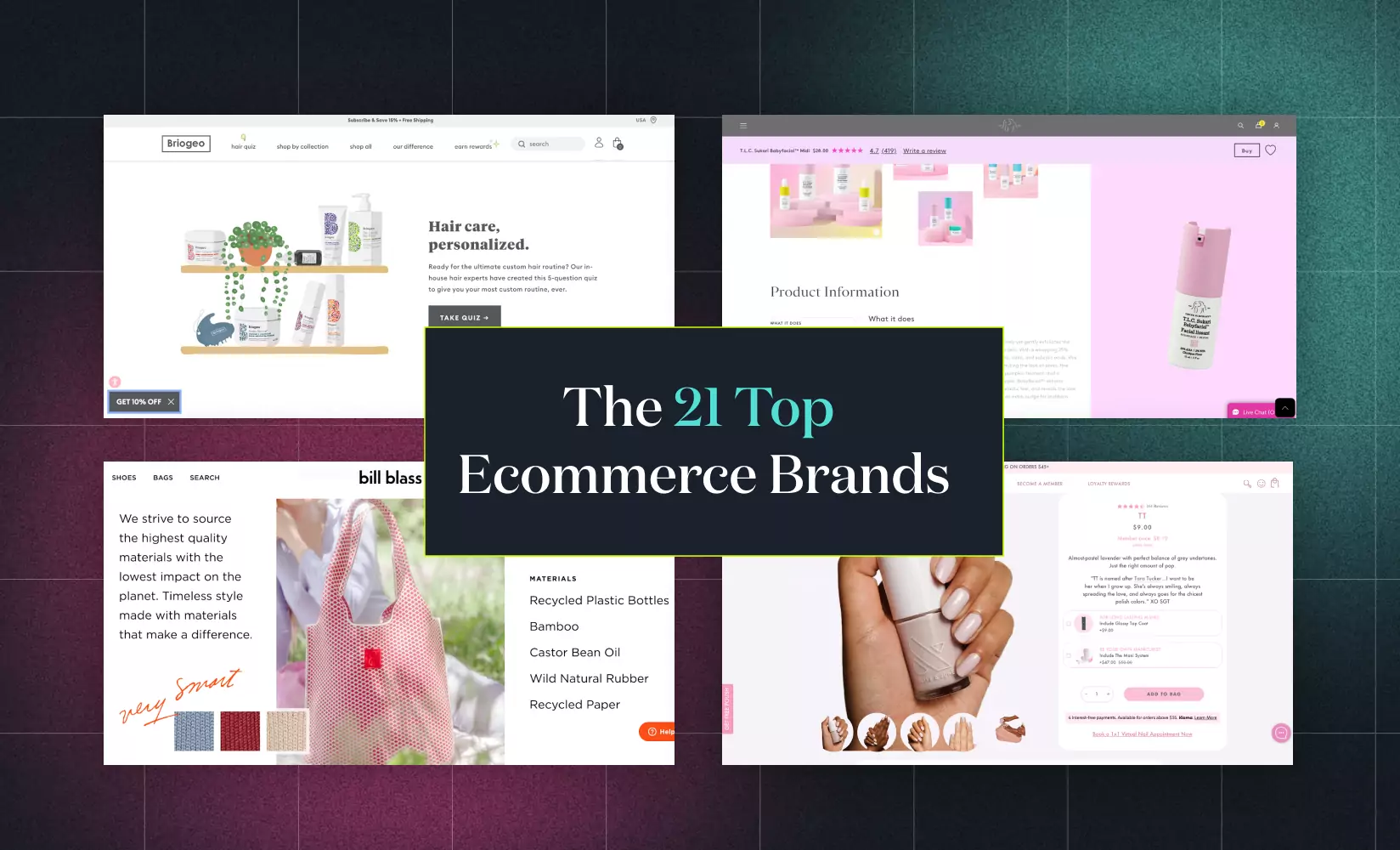
Whether you insist it’s “DTC” and not “D2C” or the other way around, it’s clear that direct-to-consumer (DTC) brands have taken over consumer shopping habits when it comes to ecommerce.
Even with the ebbs and flows of the economy, top ecommerce brands are still expected to reach all-time highs.
In fact, by 2023, the DTC industry is expected to reach $138M in ecommerce sales—nearly an 18% increase from 2022.
If you’re looking for inspiration for your DTC ecommerce site, never fear!
We’ve hand-selected 21 of the top direct-to-consumer brands, and we’re highlighting what they’re doing differently on their sites, plus sharing key DTC trends and more.
Let’s get to it! Or, you can jump ahead.
What we’ll cover here:
What is a direct-to-consumer (DTC) brand?
Direct-to-consumer or DTC brands use a business model where they sell directly to shoppers from a warehouse and bypass any middleman—like a big box store.
By removing the middleman, DTC brands gain close access to their customers (for developing loyalty) and often have more control over their owned-shopping experience as a digitally-first brand.
That’s been the standard definition for a while.
But as ecommerce continues to evolve, it may be time to redefine what being a direct-to-consumer brand means.
For example, many digitally-native brands, like Warby Parker and Allbirds, have scaled and dipped their feet into omnichannel retail to the tune of their own brick-and-mortar stores.
Further, many DTC brands run pop-up shops to take advantage of in-person retail channels. In other words, brands don’t need to run purely direct-to-consumer forever, or vice versa. The lines are blurring.
Original top DTC brand Allbirds, for example, has seen great success with their physical retail locations.
In fact, the brand told CNBC that shoppers who visited both an in-person retail store and their website spent 1.5X more than a customer who only visited one.
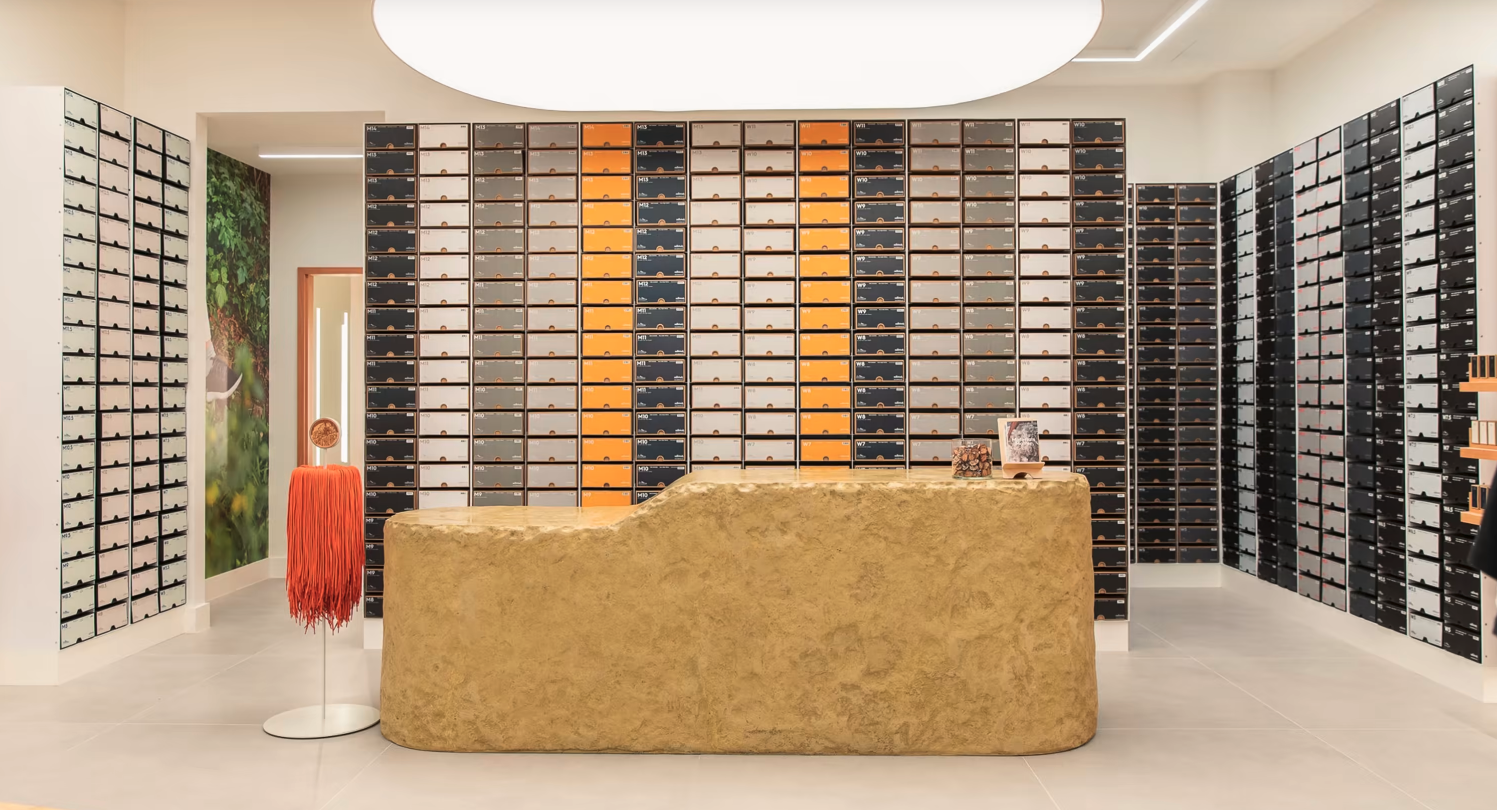
That said, here’s a new way of thinking about DTC brands:
- Digitally native vertical brands (DVNBs): Brands that got their start online and sell and ship products themselves.
- Omnichannel brands: Brands that make the majority of their sales from their owned ecommerce site but also sell through other channels.
- Traditional brands with DTC channels: These brands got their start in a brick-and-mortar setting but expanded into direct-to-consumer shopping as a channel over time.
As with other aspects of ecommerce, how brands choose to adapt and experiment with channels continues to vary. But these “buckets” can be helpful when making sense of the current DTC space.
Overall, just a few years ago, only independent or very small online-first brands would be considered ‘true’ direct-to-consumer brands.
But as the lines are blurring, this hand-picked list contains brands who fall into all ranges of DTC.
What is the average gross merchandise value (GMV) of a DTC brand?
The average GMV for a direct-to-consumer brand—or the measure of the total value of sales within a specific period—is estimated at about $1M to 5M, according to a report from PipeCandy.
What’s more, the same report found that a whopping 95% of all ecommerce businesses in the US have a GMV of less than $1M.
How many DTC brands are there?
There aren’t many stats available at this time that explicitly state how many direct-to-consumer brands exist.
However, given our broader definition of what can constitute a DTC brand, we can look to the total number of ecommerce brands operating to make an educated guess.
As of 2022, there are an estimated 12M ecommerce companies globally—excluding China. We can estimate that a good majority of them now sell with a direct-to-consumer business model.
The benefits of the direct-to-consumer business model (for customers)
There’s a really good reason—a few, actually—why DTC has taken off over the last few years. Here are two of the biggest:
- Better shopping experiences: By buying directly from a brand, customers get a 1:1 interaction with that brand. On the flip side, brands have the chance to create memorable shopping experiences for customers with owned customer data—like a personalized email with suggested products based on browsing history. And the impact is significant: 61% of customers say individual brands offer a more personalized shopping experience.
- Improved relationships/communication: Interacting with a brand directly—opposed to working through a middleman—means brands and shoppers can form great relationships, and shoppers more regularly get the one-to-one communication they’re looking for. For example, your customer service team can wow shoppers with interactions, which would be challenging to do if you sold solely through a middleman. The numbers don’t lie: 66% of customers say it’s easier to understand the values of individual brands.
3 Major DTC trends to watch
Before we jump into the good stuff (examples galore!), here’s a look at what’s happening in the DTC space you need to know:
Trend 1: More traditional retailers are dipping into DTC
The success of the DTC industry has prompted traditionally business-to-consumer (B2C) brands to test out this business model.
For example, women’s shave brand Venus launched a subscription DTC offering that allows shoppers to customize a subscription package—down to the razor handle color and delivery cadence.

Big brands are learning the value of omnichannel retail and are doubling down on the success of an online-only offering.
Trend 2: DTC brands are breaking out of their design shell
A criticism of DTC brands that’s garnered an array of thought pieces is that they all look the same from a design lens.
This criteria typically includes a color palette using Millennial pink or Gen Z yellow and a trove of soft lifestyle images and simple, clean fonts.
Jake Underwood, the App Store Editor at Apple, says these brands have prioritized becoming “Instagram-worthy”:
“In a world of over-saturated feeds, startups are going counterculture by stripping away distractions, endorsers, and flashy graphics. Instead, their ads are broken down into two parts: the product and a plain background.”
These brands have adopted a certain trending aesthetic that shoppers can’t get enough of—or can they?
As more brands aim to break through the design status quo and break past limits with traditional ecommerce platforms, we’re seeing more dynamic design across DTC niches (even if the brand identity aesthetic from a DTC is minimal). We’ll get to those examples shortly!
#cta-mini-pb#Get more stunning ecommerce store examples. Download our ebook
Trend 3: DTC brands are getting creative with collecting zero-party data
In 2020, Google announced it was cutting cookies from Chrome, and even though that rollout has encountered a few roadblocks, DTC brands are already needing to get creative with sourcing their own data.
Zero-party data—or data a customer intentionally shares with a brand—has become top-of-mind for brands who may lose out on traditional data-collecting methods.
Some DTC brands are using quizzes, as Briogeo does with their hair quiz, to collect proprietary customer data:
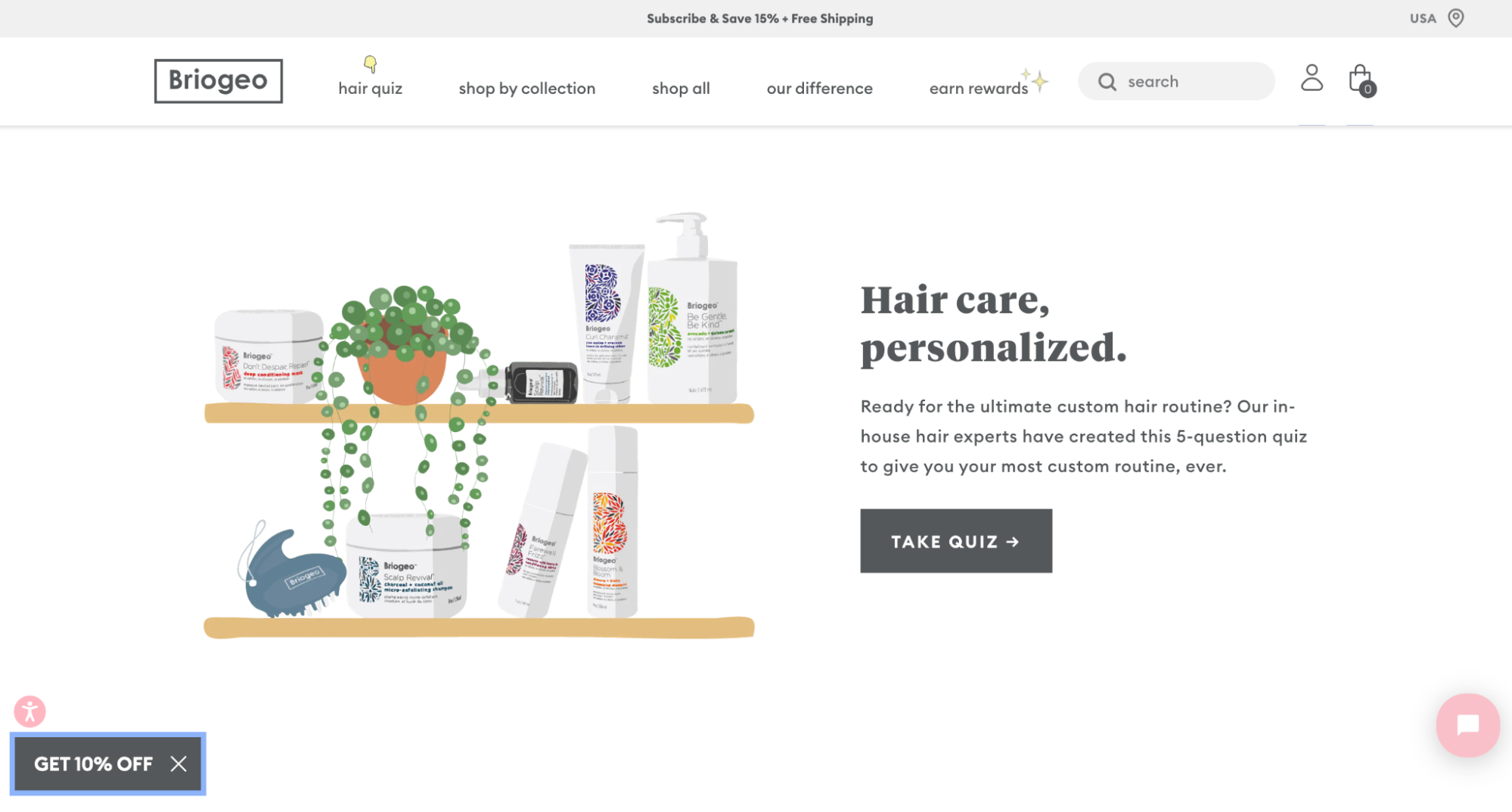
Other methods for this DTC data collection include post-purchase surveys, social media polls, and even account creation.
The top 21 direct-to-consumer brands in ecommerce (& their best customer experience plays)
Without further ado, here’s our list of top DTC brands in 2022 and beyond. We’re sure you’ll find lots of inspiration—you’ll want to bookmark this one!
Beauty and personal care DTC brands
For scaling beauty, personal care, and skincare brands, there’s never been a better time to be in business.
Even with the trying times of the economy and evolving ecommerce landscape, the beauty industry as a whole is set to surpass 90 billion by 2023.
Here are some notable brands making a splash in this space.
1. Jupiter
Company size: 2-10
Founded: 2020
Headquarters: New York, NY
Jupiter is a scalp-health DTC brand offering a variety of products based on need with good-for-you ingredients.
This DTC brand’s best CX move: What makes Jupiter products superior to ol’ standbys like Head and Shoulders? Their ingredients and DTC site design elements that highlight them.
Jupiter doesn’t just tell you their products are made with all-natural ingredients, they show you as you explore the site via vibrant, interactive imagery.

When customers mouse over a product image, it reveals the ingredients used in that particular product. A great way to emphasize they’re serious about what goes into their products.
2. Jones Road Beauty
Company size: 11 – 50
Founded: 2020
Headquarters: Montclair, NJ
Jones Road is a clean, non-toxic makeup line designed for every age, skin type, and skin tone.
This DTC brand’s best CX move: Shopping for makeup online is tough. How do you know if the shade of foundation or blush in your cart is really the right shade? To make this easier—and to collect zero-party data from customers—Jones Road has three quizzes customers can take to find their exact product match.
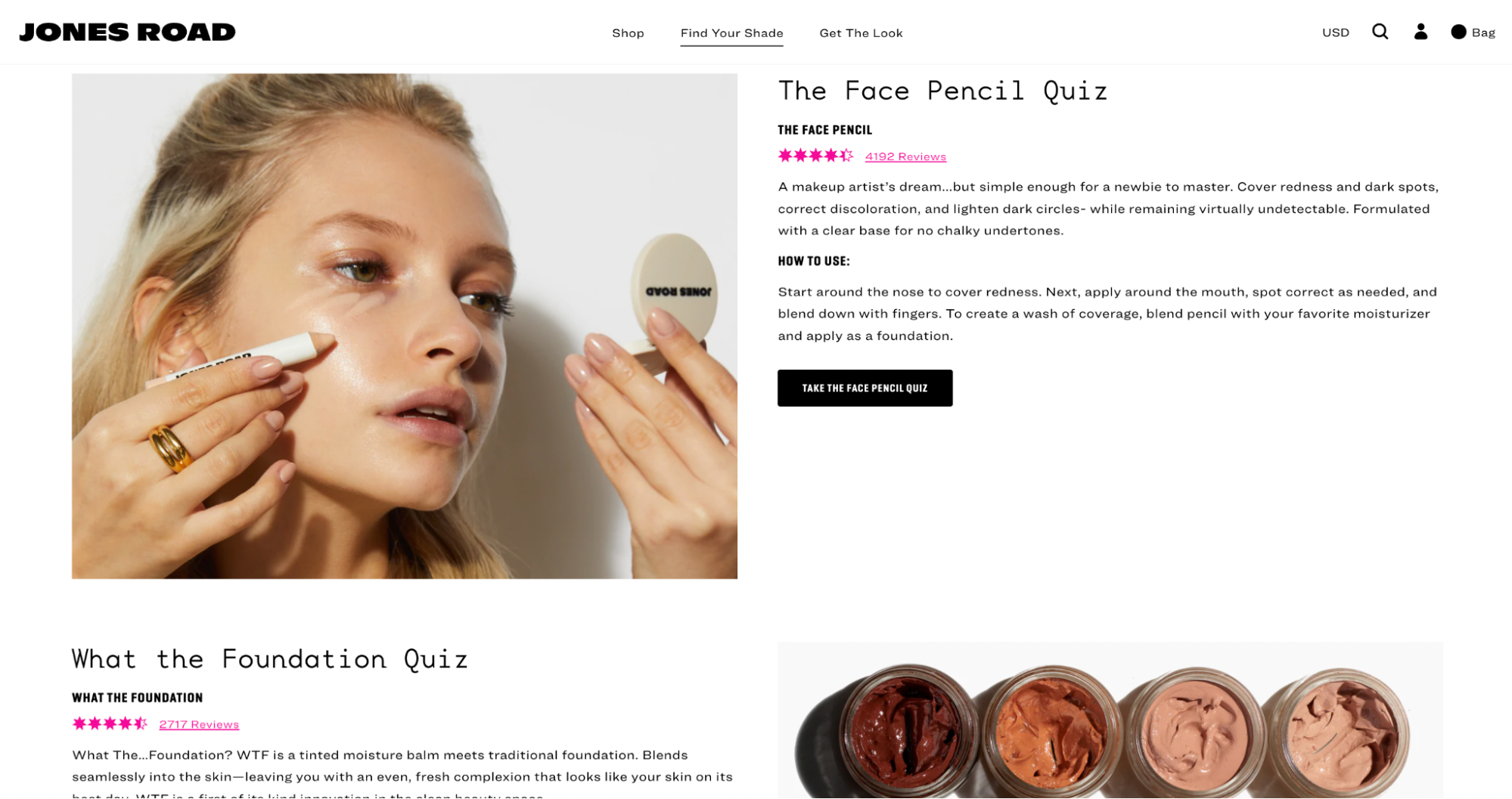
Not only do these quizzes help customers find the right products, but this page also tells them how to use each product.
Helping shoppers aside, these quizzes allow Jones Road to collect zero-party data and craft personalized emails, relevant SMS messages, and other campaigns.
3. Drunk Elephant
Company size: 51 – 200
Founded: 2012
Headquarters: Houston, TX
Drunk Elephant is a personal care brand that uses ingredients based on biocompatibility.
This DTC brand’s best CX move: When shoppers land on the Drunk Elephant site, they’re met with a trove of design darlings: vibrant product imagery, bold color blocks, statement-size text, unique scroll effects, and more.
These elements instantly give shoppers—whether they’re familiar with the brand or not—a sense of the Drunk Elephant brand ethos, and what they can expect.
But more than just an awesome-to-look-at site, all site content feels like its own unique experience. For example, each product page includes images, colors, and a how-to-use video specific to the product:
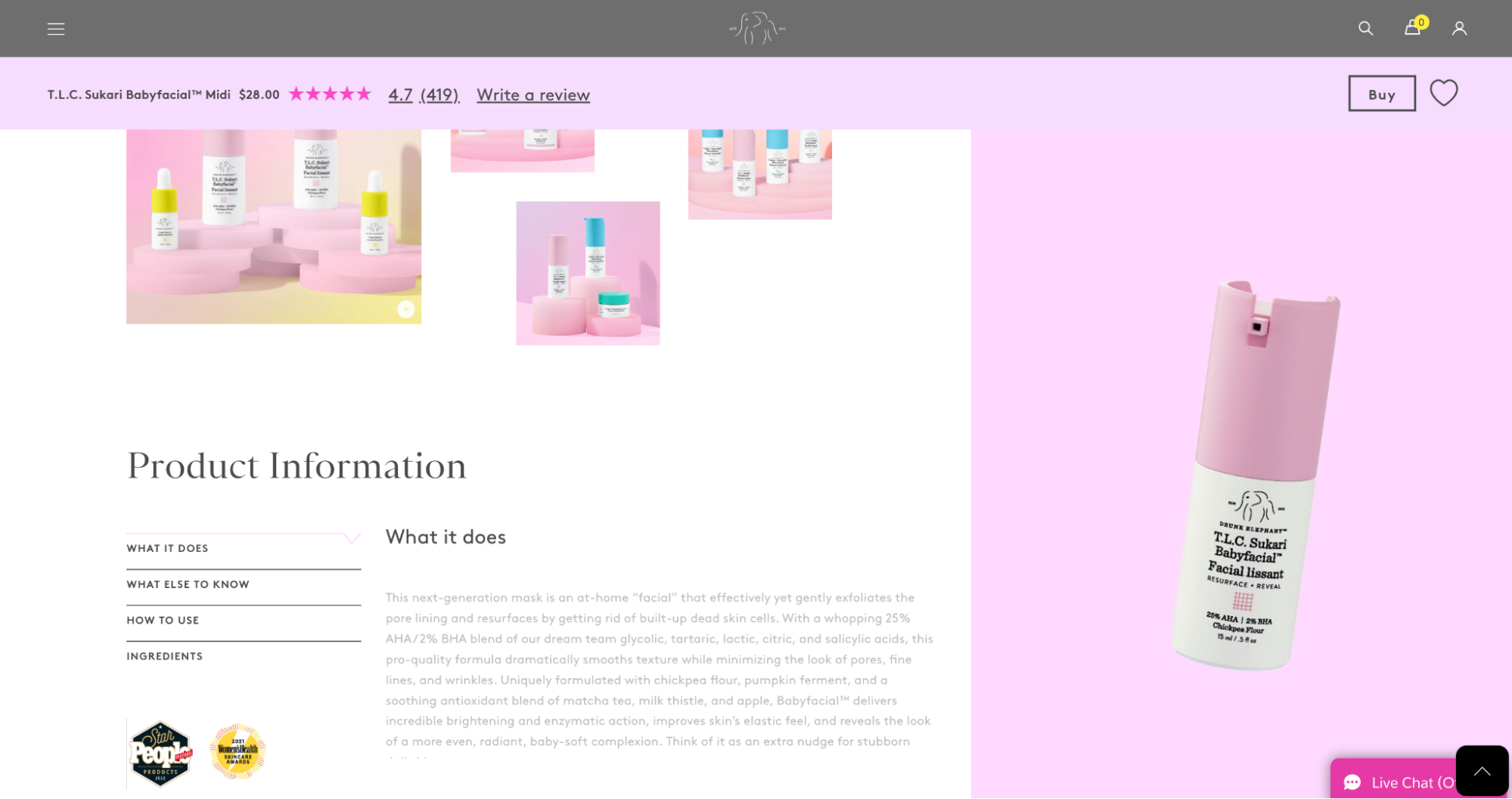
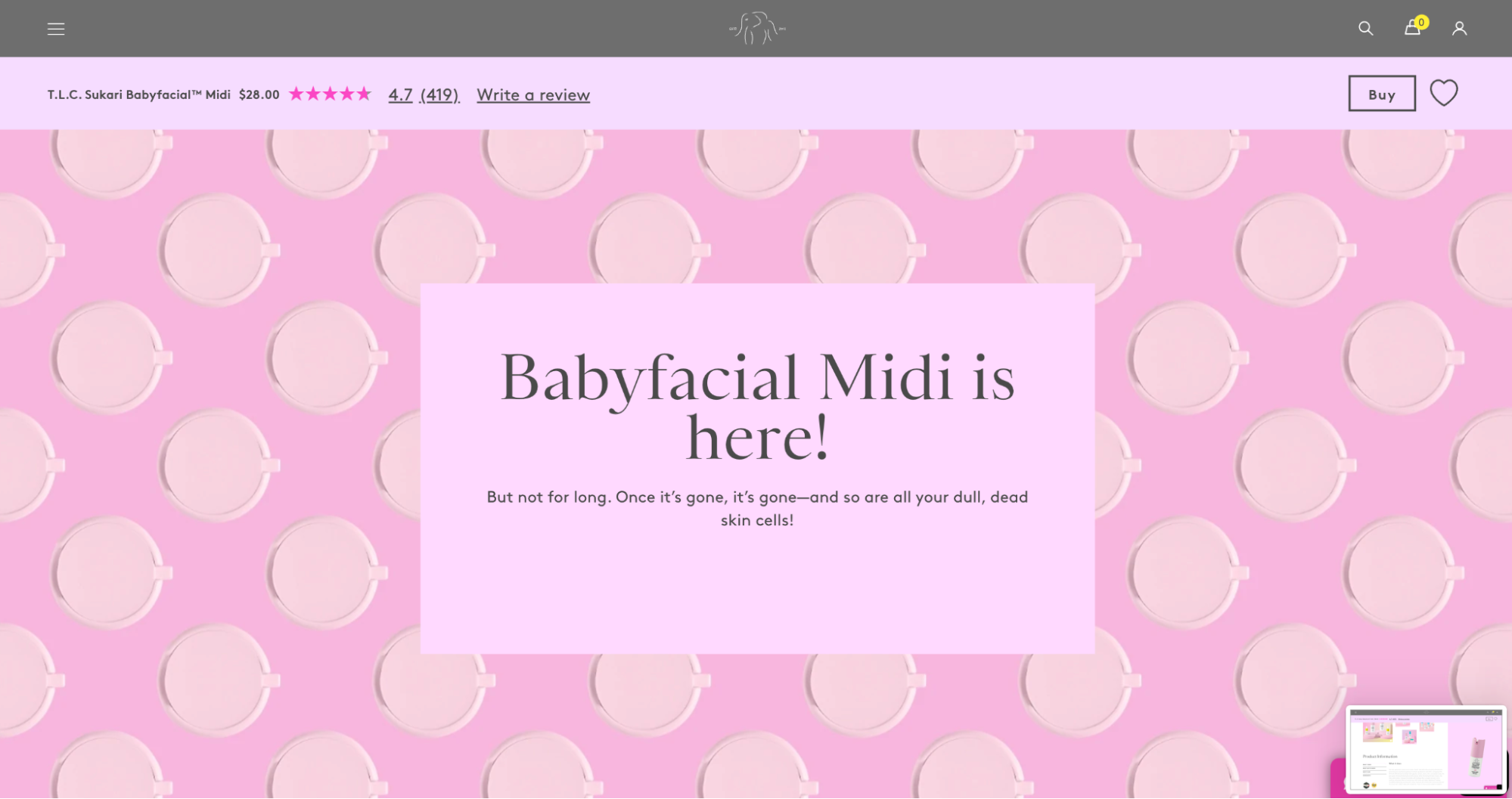
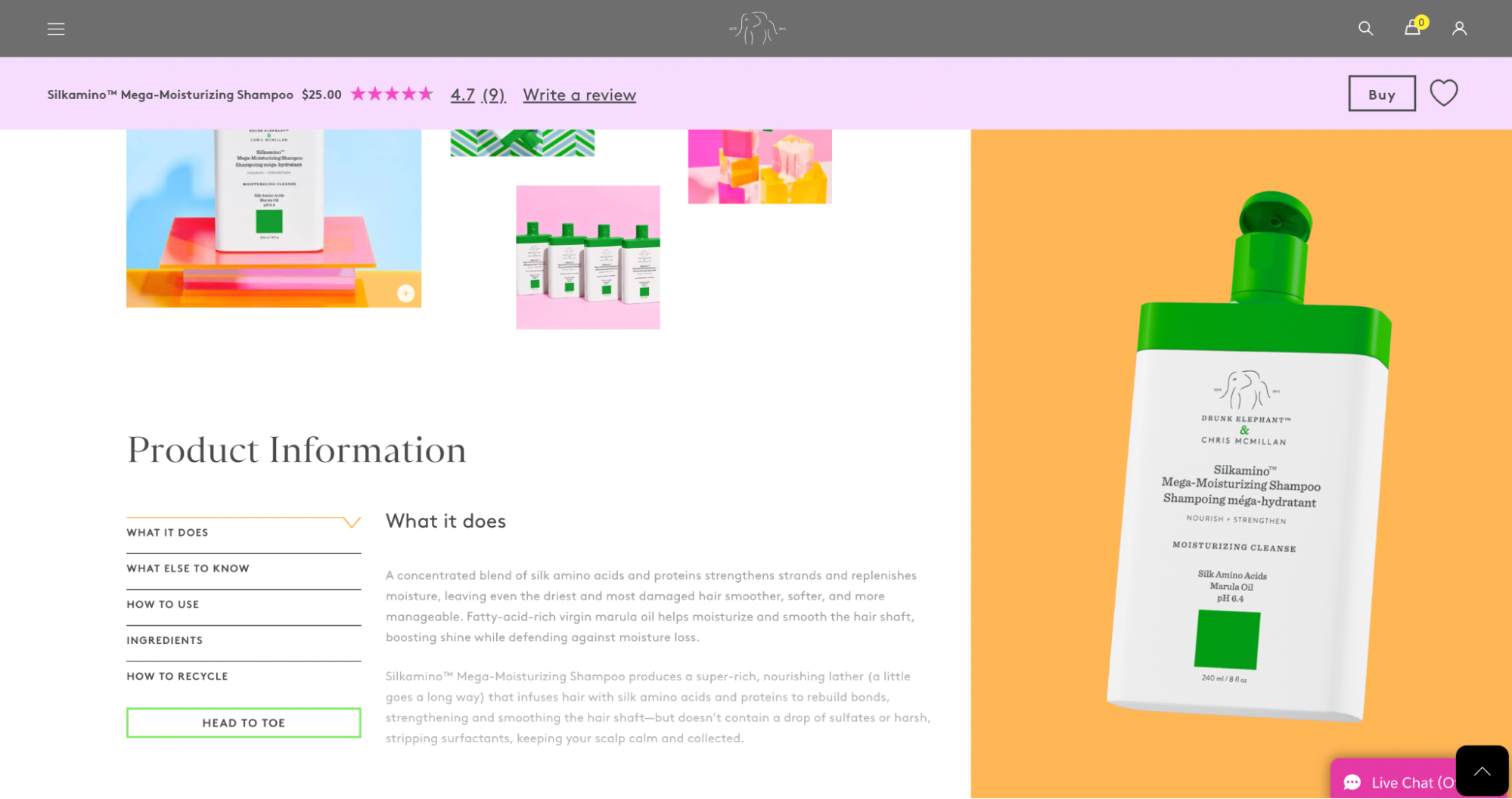
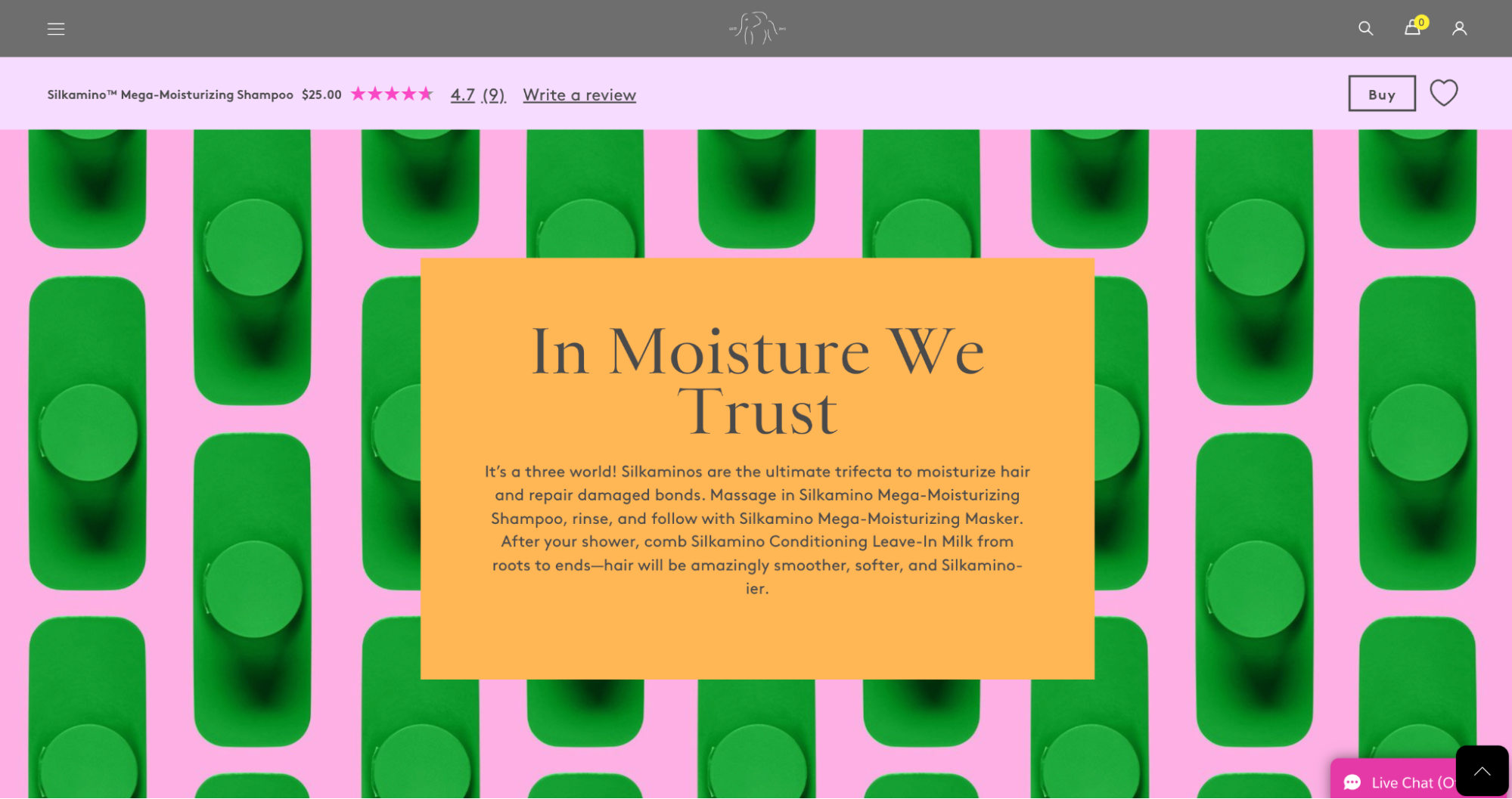
While the structure of the product pages is the same, Drunk Elephant makes each feel unique using product-specific colors and images.
This makes for a super memorable, elevated shopping experience.
Drunk Elephant’s approach to design—engaging visuals paired with educational components—acts as a tour guide as customers shop the site.
4. OneBlade
Company size: 2 – 10
Founded: 2014
Headquarters: Austin, TX
OneBlade is a subscription-model luxury shave brand offering high-quality razor products and associated accessories.
This DTC brand’s best CX move: As OneBlade scaled their operations, they wanted to reduce the number of pages required in their checkout flow.
“We’ve found that most people are ready to buy after they see a given product’s landing page,” said Josh Nash, OneBlade’s former CMO. “So, we wanted to make that experience much faster and easier—all from our landing pages on the site.”
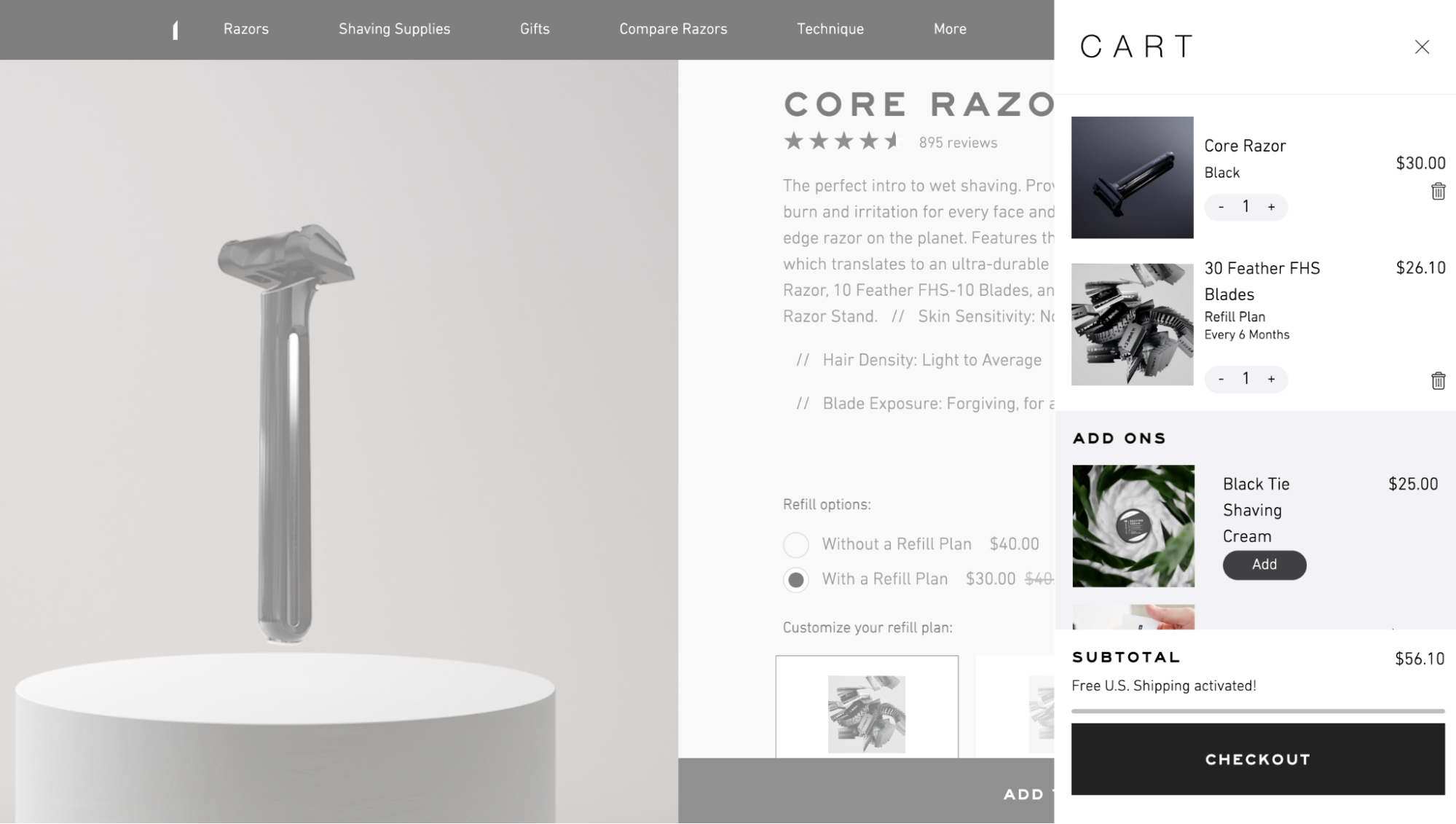
Before taking their site headless, OneBlade customers viewed (on average) seven pages before purchase.
After launching their new site, they reduced the average number of pages before a purchase to just two. This means shoppers are finding what they’re looking for—and heading to checkout—faster.
5. TULA Skincare
Company size: 51 – 200
Founded: 2014
Headquarters: New York, NY
TULA Skincare is a clean and effective skincare brand built on the power of probiotic extracts and superfoods clinically proven to nourish, soothe, and balance skin.
TULA began as a digitally-native vertical brand (DNVB)—or, a brand that started online but now sells in physical retail stores like Ulta and Sephora—and has grown into an omnichannel brand with a cult-like following.
This DTC brand’s best CX move: For those in the beauty and skincare industry, you know all too well how important imagery is to your online shopping experience.
TULA takes this to heart and includes rich imagery—both product and lifestyle—throughout their ecommerce store.

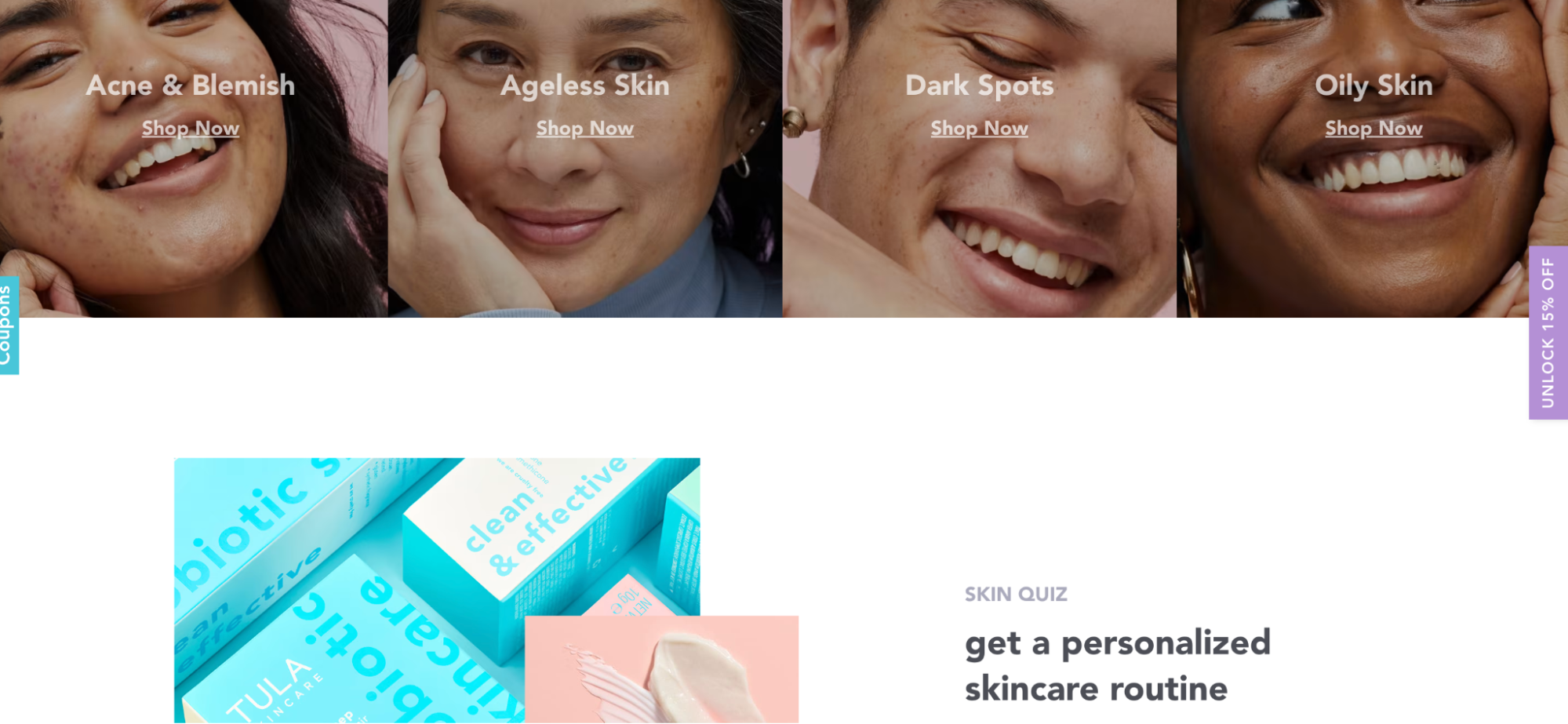
Adding stunning visuals to an ecommerce site isn’t anything new, but what makes TULA stand out is that they add this imagery without impacting their site performance.
TULA turned to headless commerce and is now able to include stellar brand visuals anywhere on the site without tanking site performance (something brands have long had to compromise on).
Home decor and lifestyle DTC brands
6. Clare
Company size: 2 – 10
Founded: 2018
Headquarters: New York, NY
Clare is a next-generation paint company on a mission to make shopping for paint online easier, faster, and more exciting.
This DTC brand’s best CX move: DTC paint brand Clare understands the importance of context when shopping online. Because of this, they include several elements on their site that give shoppers more information—whether it be how paint colors look in a space or how to use their peel-and-stick paint swatches.
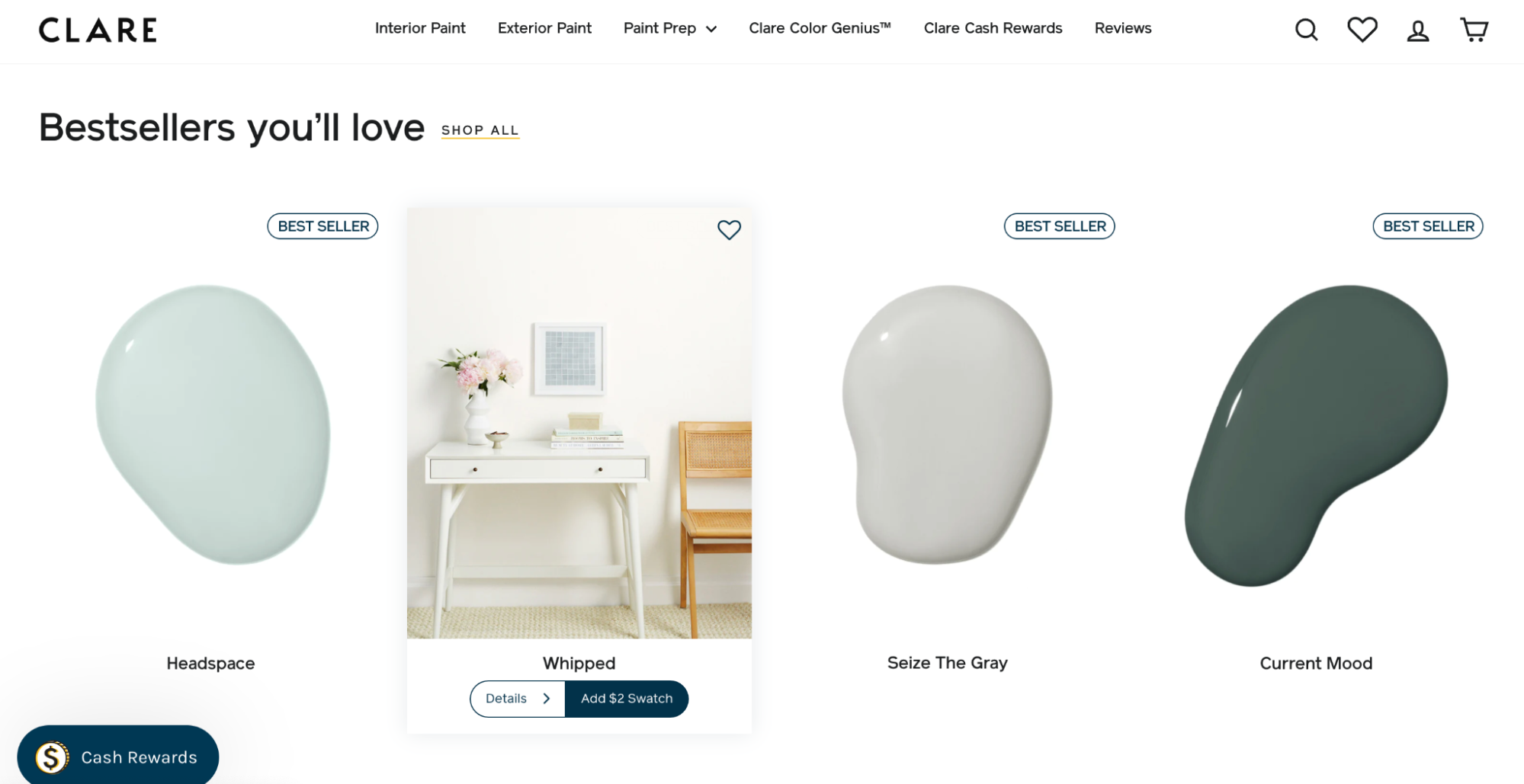

Contextual information like this can help customers along to checkout and reduce the chance of return.
In fact, a study from Weebly found that 75% of respondents say that product images are “very influential” in whether they purchase, and 22% say they returned items because it looked different IRL than in the image.
Design elements like this add value to the overall customer experience, which can be the difference between a conversion and a bounce.
7. Moooi
Company size: 11 – 50
Founded: 2001
Headquarters: Antwerp, Belgium
Moooi is an innovative, imaginative furniture and design brand that challenges the status quo of functional, everyday furniture.
This DTC brand’s best CX move: When you first navigate to Moooi.com, you’re instantly taken to a new world: Moooi’s world. Their ecommerce experience is stunning—visually and technically—and blurs the lines of art and function.
But what stands out is how they merchandise their site to match new product launches:
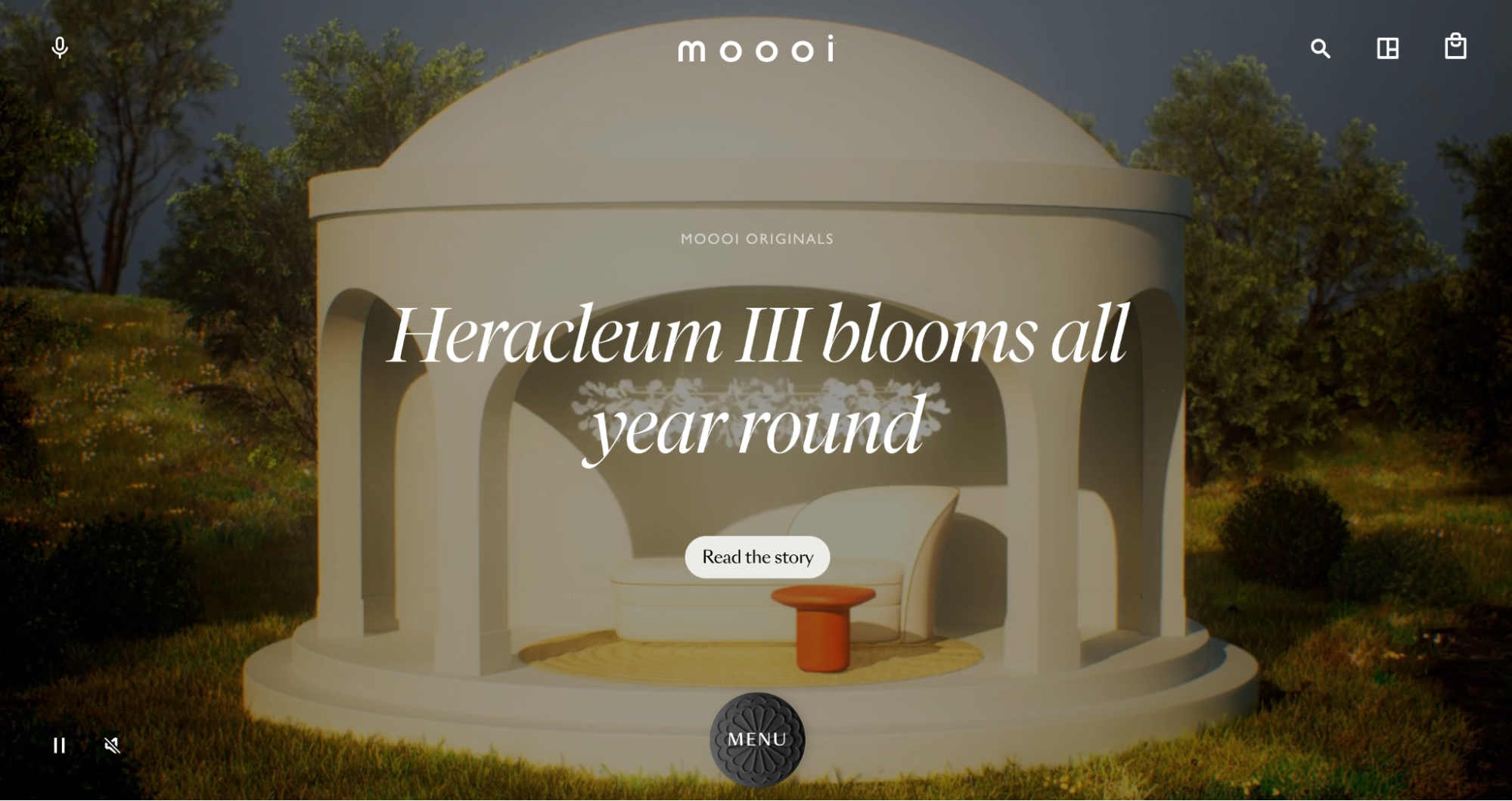
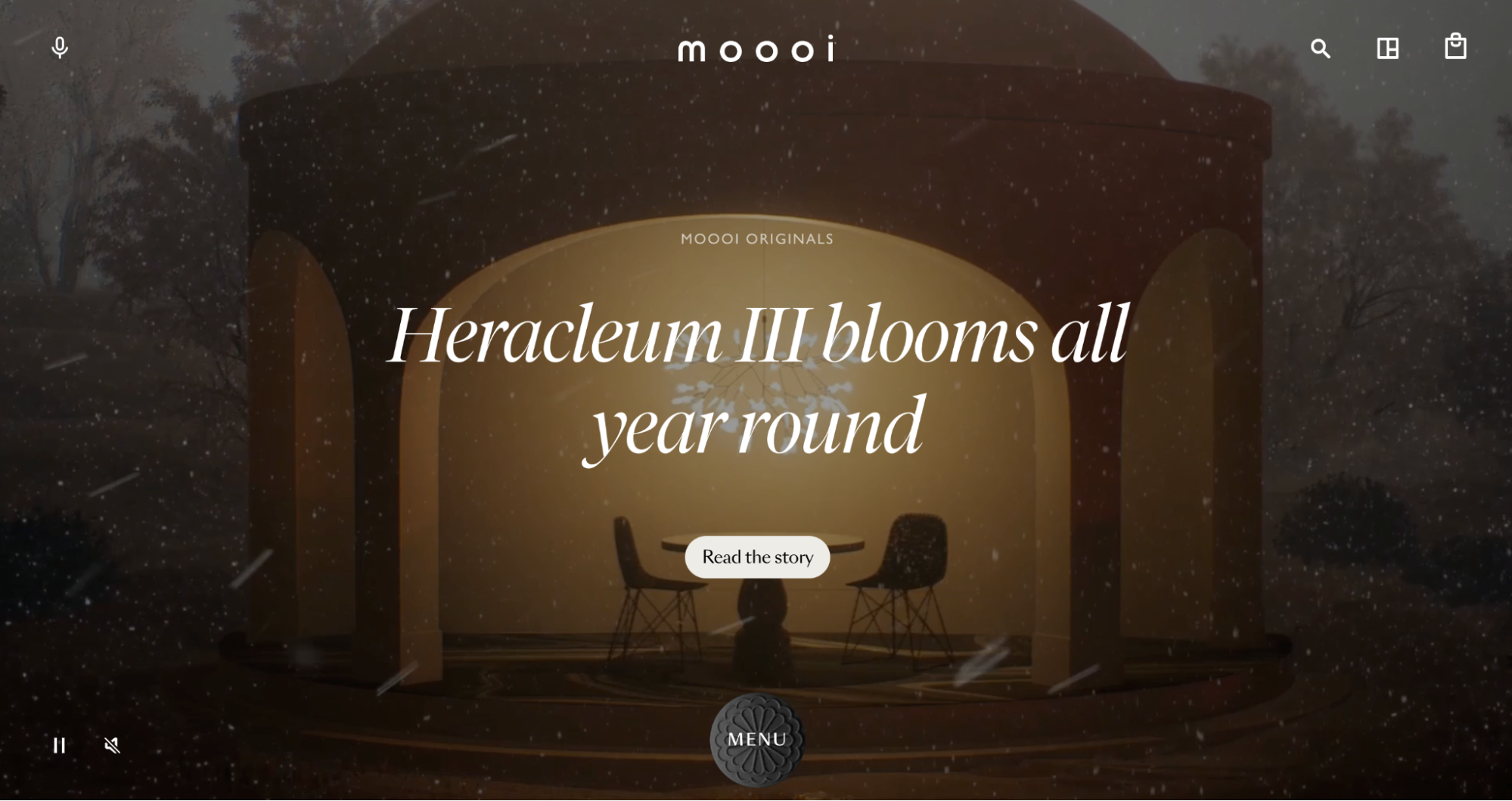
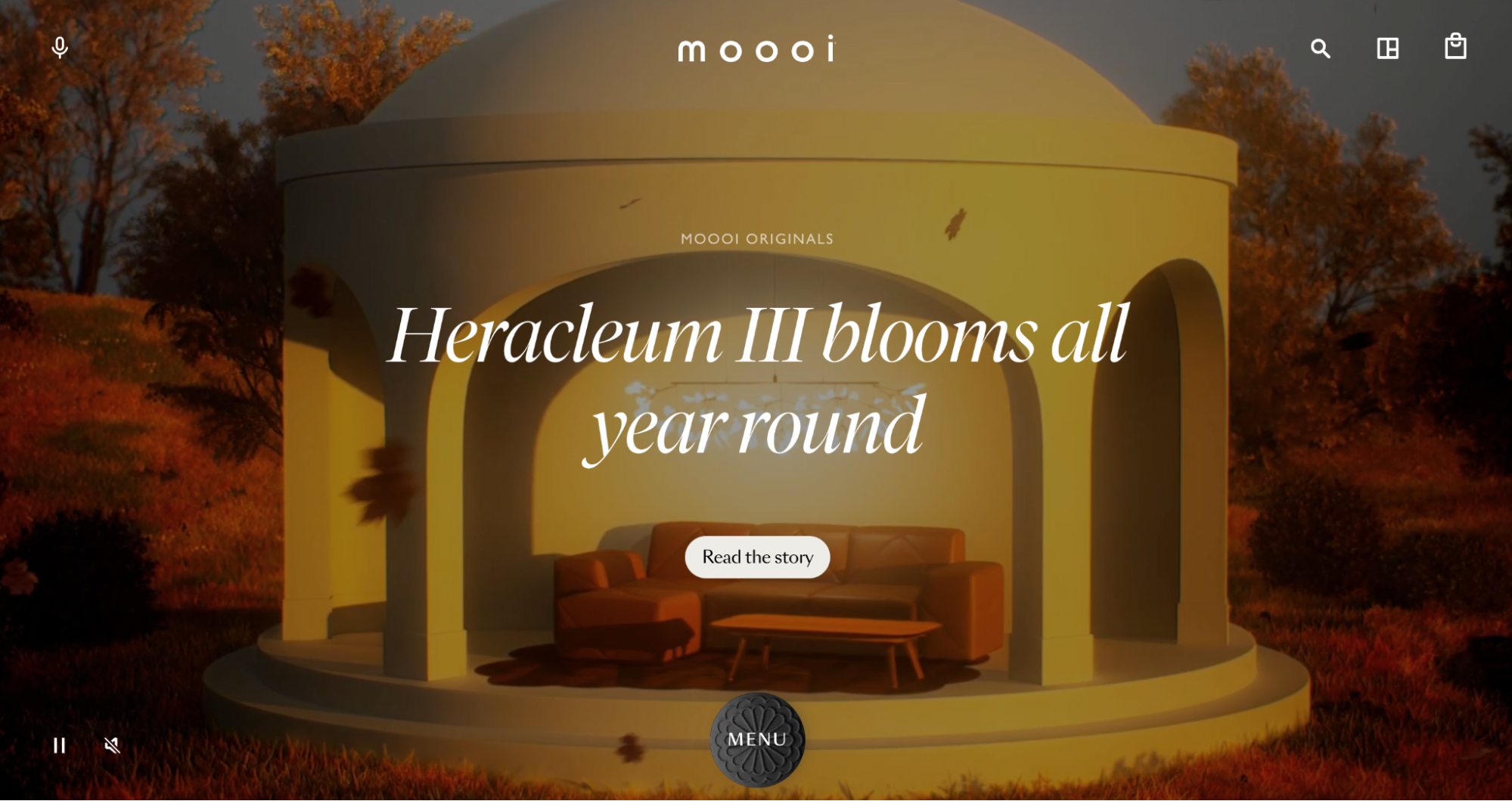
This hero background video highlights a new chandelier product—the Heracleum III—but in a way that showcases its versatility.
As the video loops through different seasons and rooms, shoppers can see that while this piece is clearly stunning and museum-worthy, it’s still an everyday functional piece worth the $4,600 price tag.
8. Stikwood
Company size: 11 – 50
Founded: 2012
Headquarters: Sacramento, CA
Stikwood is a modern home decor brand making high-end design accessible and affordable. They offer peel-and-stick wood planking and other furnishings, like headboards, shelving, and more.
This DTC brand’s best CX move: Stikwood is dedicated to making shopping online for their customers’ next DIY project a breeze.
Stikwood added a “see it in your space” tool after launching their headless-powered ecommerce site, which allows customers to test how a certain product looks in their space.
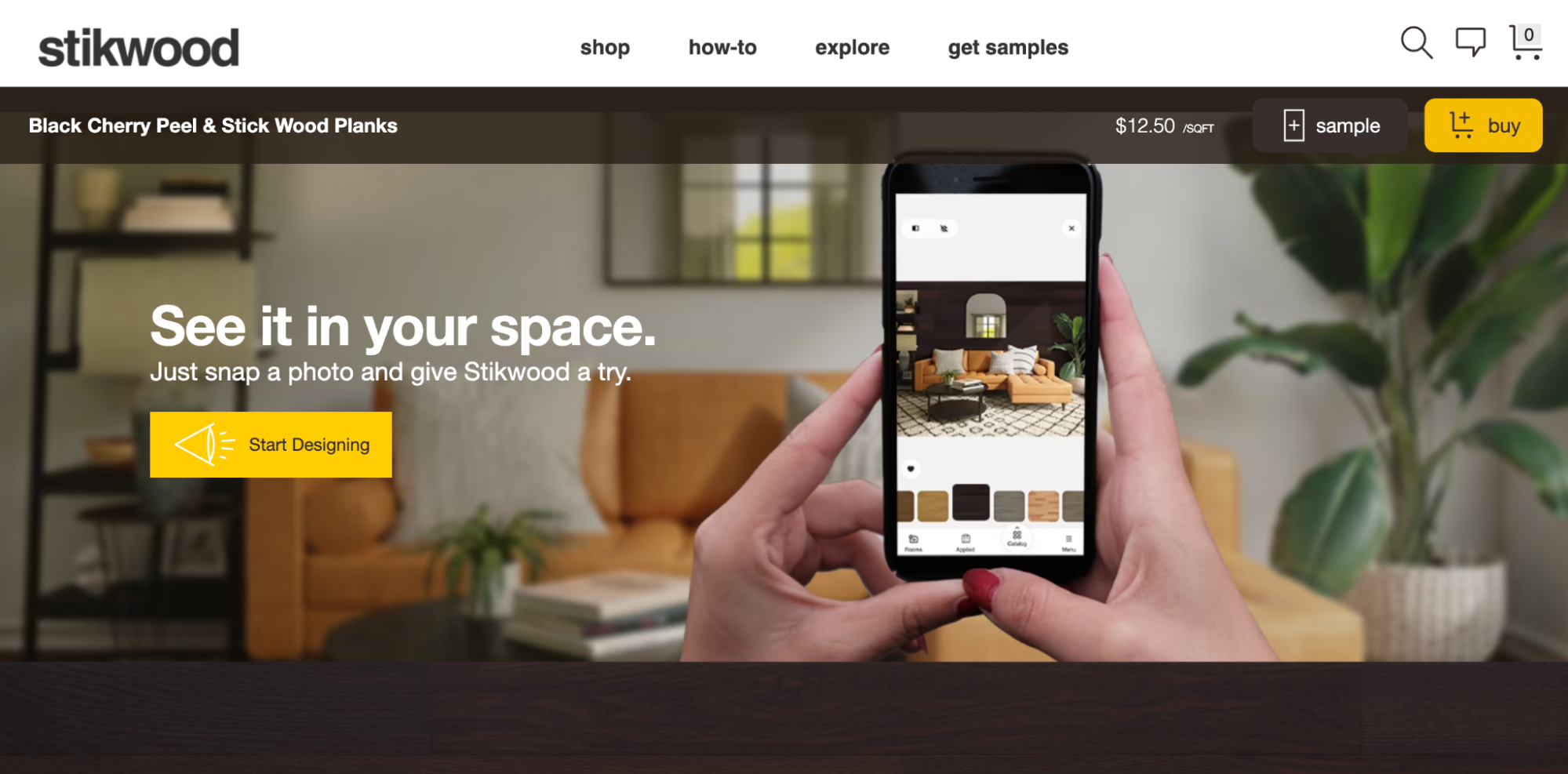
Features like this have increased Stikwood’s site engagement and boosted users’ time on page by 15%.
What’s more, since launching their new site, Stikwood has generated 1M+ page views, 72% of which were mobile shoppers—proving the effectiveness of this tool.
9. Caraway
Company size: 11 – 50
Founded: 2018
Headquarters: New York, NY
Caraway offers well-crafted, non-toxic ceramic cookware.
This DTC brand’s best CX move: Caraway goes above and beyond with their drawer-style shopping cart. Shoppers not only can see the products they’ve added to their cart, but they can “complete” their kitchen by adding other products (and choosing the product color!) right within the cart.
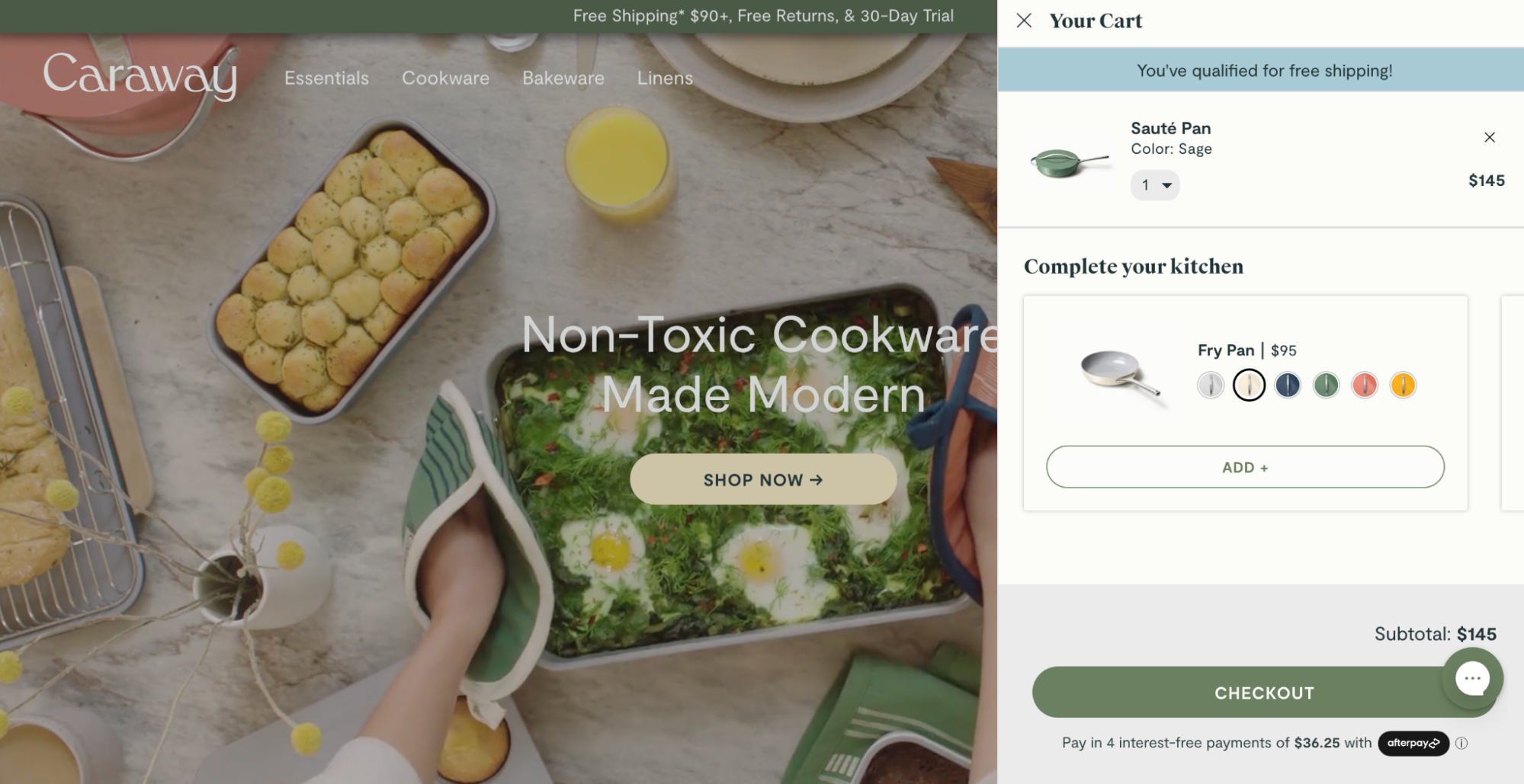
This feature not only primes them for boosting AOV, but it makes it easier for customers to discover relevant products.
#cta-visual-pb#<cta-title>Build a better Shopify store<cta-title>Make your store look and feel as unique as your brand by customizing with the best page builder for Shopify.Start building for free
10. Nomad
Company size: 11 – 50
Founded: 2012
Headquarters: Santa Barbara, CA
Nomad is a luxury consumer electronics and lifestyle products company built for those on the go.
This DTC brand’s best CX move: Design is a core part of the Nomad brand. As such, the team aims to create enriching shopping experiences that are unique to each product they sell.
After launching their headless progressive web app (PWA), the team added multiple variants to each product page, which remerchandises the entire page as customers toggle between product colors.
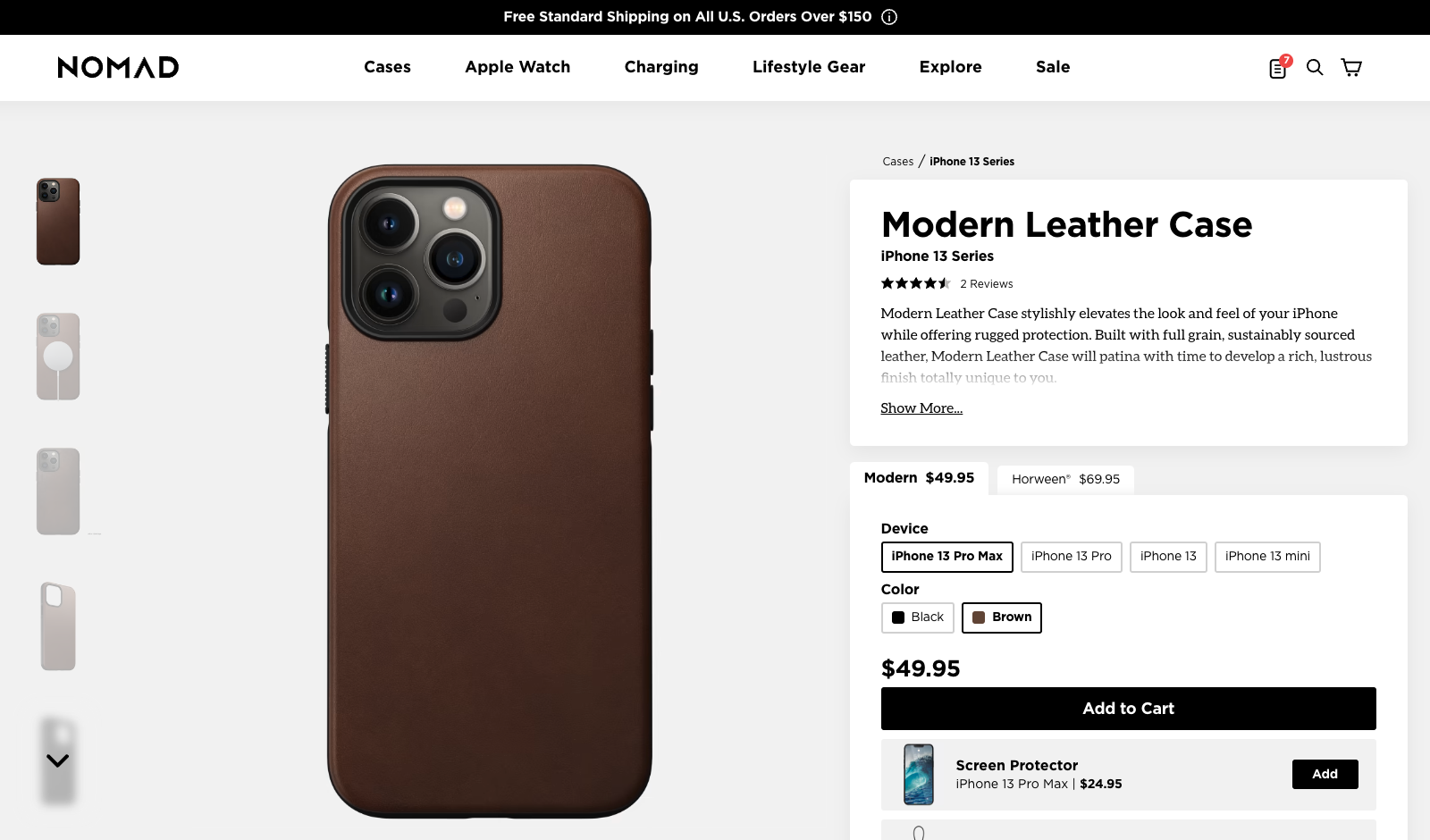

For example, if you’re on an iPhone case product page and click between product colors, you’ll notice the entire page will remerchandise with the matching product images. In other words, if you click on the rustic brown color, you’ll see product images in the rustic brown color.
As Nick Walden, the Creative Director at Nomad said:
“Our flexible frontend allows us to add multiple variants easily and involves the entirety of site content. This makes for a more precise, customer-centric shopping experience.”
This type of immersive shopping experience is what makes Nomad stand out from other brands, especially in their niche.
Wellness DTC brands
According to McKinsey, the wellness industry is batting in the trillions.
With shoppers looking for ways to stay healthy from the comfort of home, it’s no wonder brands like the ones we’ve rounded up below are taking off.
11. Huppy
Company size: 3
Founded: N/A
Headquarters: Los Angeles, CA
Huppy offers plastic-free, better-for-you alternatives to dental care—like toothpaste tablets, mouthwash, and more.
This DTC brand’s best CX move: It’s clear Huppy’s target market is health-conscious consumers looking to make smarter choices. Why?
Their ingredients page offers a side-by-side comparison of what’s in their products and what’s in their competitors’ products.
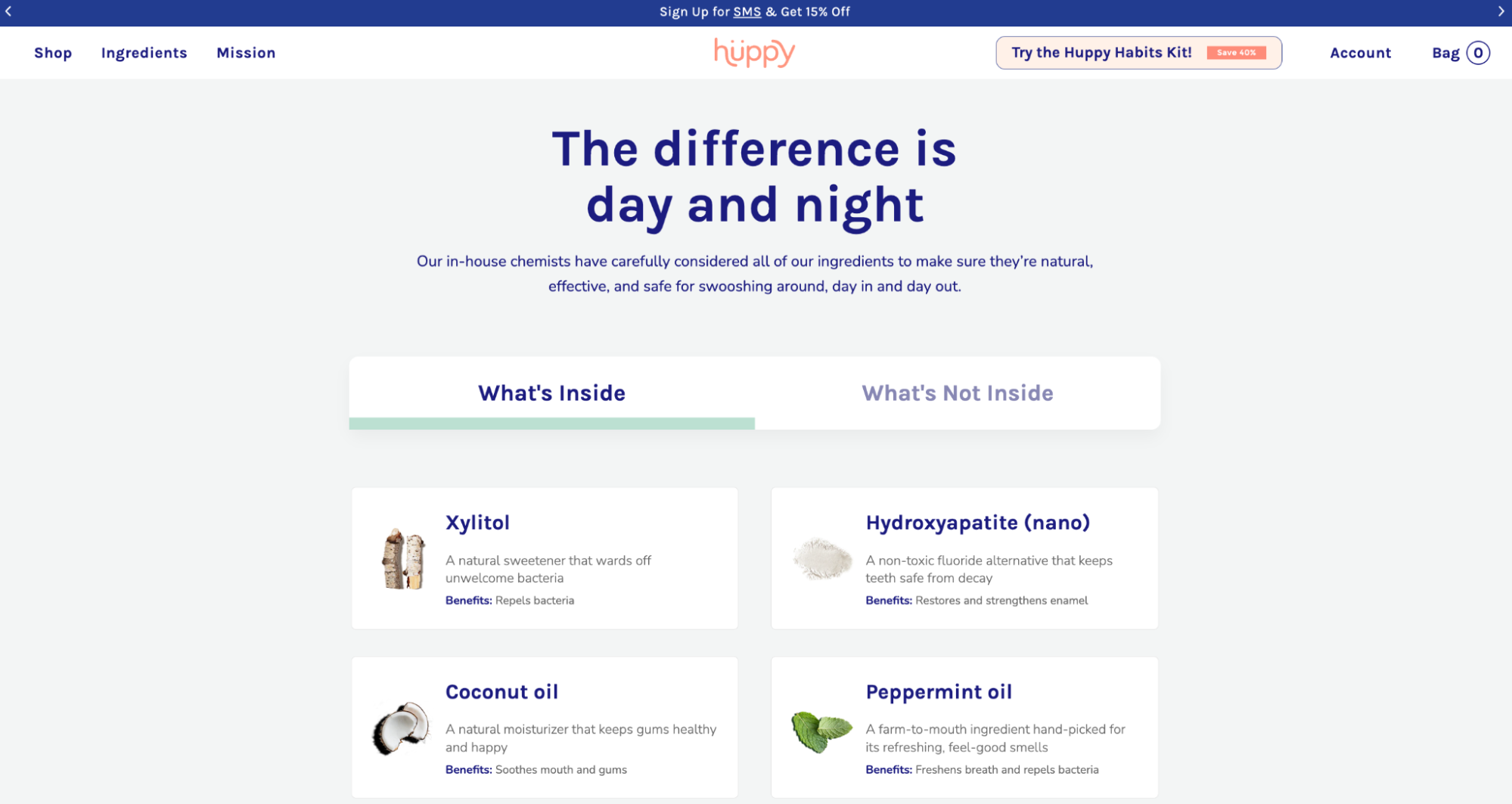
This page allows customers to discover what’s in Huppy’s products, but it sheds light on problematic ingredients found in the big brand toothpaste products.
This juxtaposition makes the case for why health-conscious shoppers should consider switching to Huppy.
12. Olive & June
Company size: 51 – 200
Founded: 2013
Headquarters: Beverly Hills, CA
Olive & June is on a mission to perfect the at-home manicure game with high-quality, beautiful nail polishes, press-ons, kits, and more.
This DTC brand’s best CX move: Olive & June knows how challenging it can be to pick out a nail polish color online.
They make it easy with product page remerchandising, images of nail polish colors on different skin tones, and ample UGC for customers to browse.
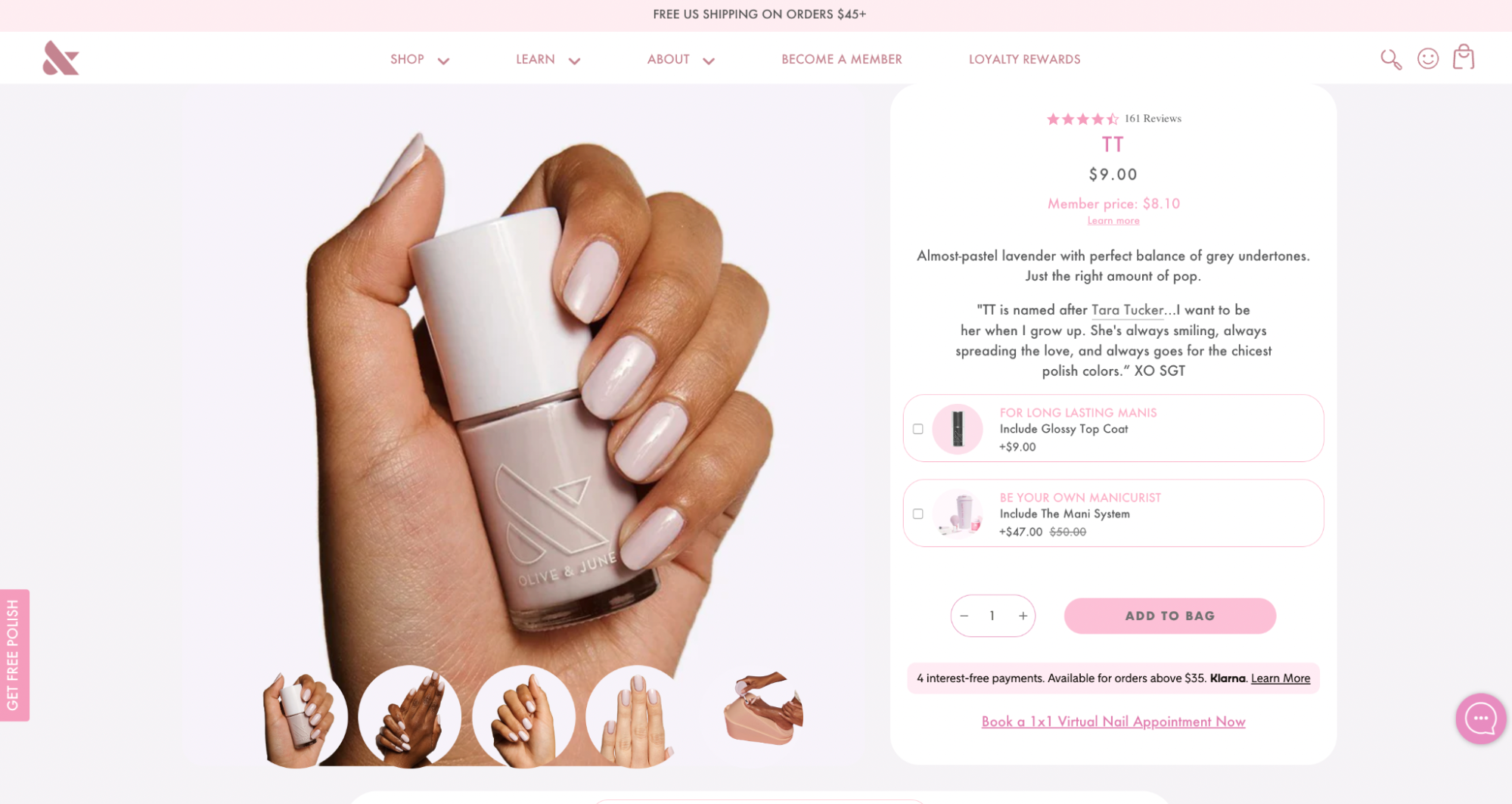
This kind of context helps shoppers narrow down the color—or colors—they want to purchase.
Press-on nails might seem like a no-brainer concept, but Olive & June is here to tell you school is in session.
Olive & June offers Olive University—an online boot camp that teaches press-on nail-curious customers about how to make the most of their purchase.
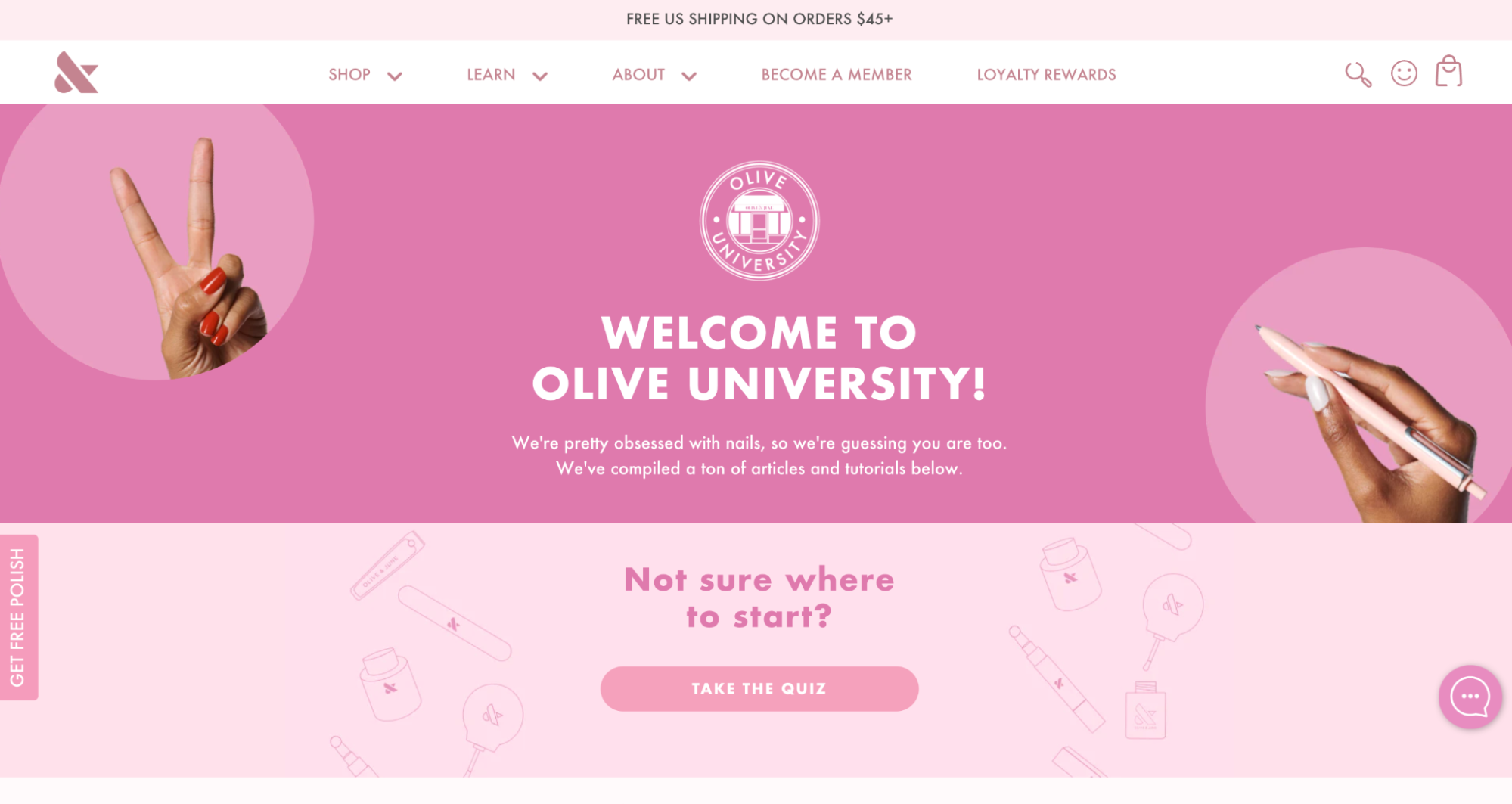
This educational effort helps promote customer success (i.e., people are using the products correctly) and, as a result, boosts customer satisfaction.
Educational site content for the win!
13. The Feed
Company size: 2 – 10
Founded: 2013
Headquarters: Boulder, CO
The Feed is a nutrition and wellness marketplace with the goal of making the best products available to athletes of all kinds.
This DTC brand’s best CX move: As a marketplace, a major priority of The Feed’s is to help customers see as many site pages as possible within a single session. More site pages in one session = more products discovered.
The Feed.com’s lightning-fast speed not only helps customers see more pages, but it creates a better overall shopping experience.
After all, the chances of customers bouncing from your site increase by a whopping 32% on average when a page load time goes from one to three seconds.
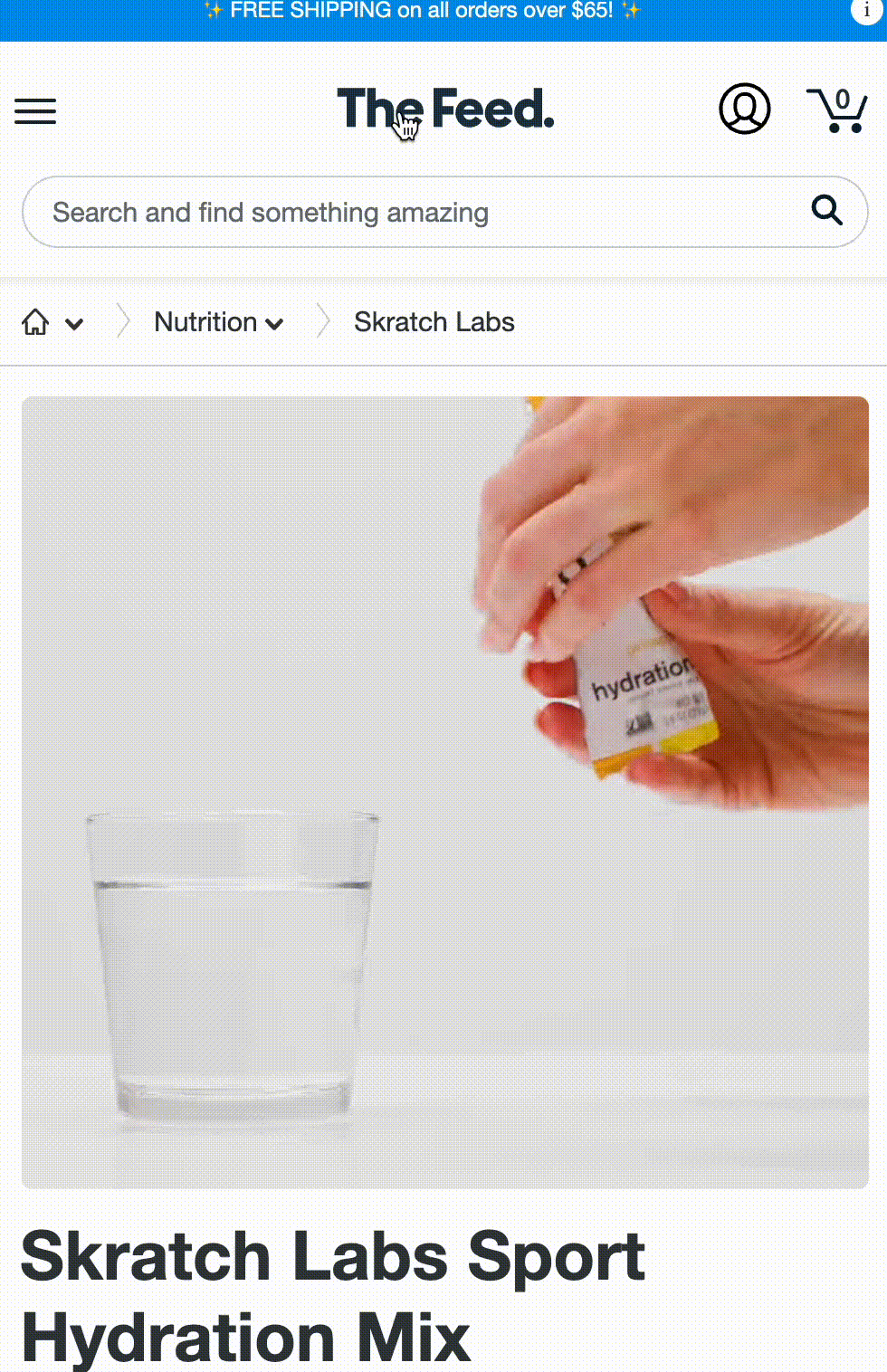
Before launching their headless site, The Feed experience site speed issues and had trouble keeping customers on the site as a result.
But after launching their new site, they’ve not only increased their number of pageviews per session by 10.8% and ecommerce conversion rate by 5.2%, but they’ve decreased their bounce rate by 4.5%.
Apparel DTC brands
The fashion ecommerce industry is expected to hit $672 billion by 2023. In other words, shopping for clothes online isn’t going away anytime soon.
Let’s look at some of the rising stars of the apparel DTC industry:
14. FLEO
Company size: 11 – 50
Founded: 2016
Headquarters: The Woodlands, TX
FLEO is a strength and training apparel brand for women.
This DTC brand’s best CX move: FLEO makes fitness clothing for the everyday woman, so what better way to highlight how important that is to their brand than with visuals of their target customer placed throughout their ecommerce site?
Whether it’s in product shots:
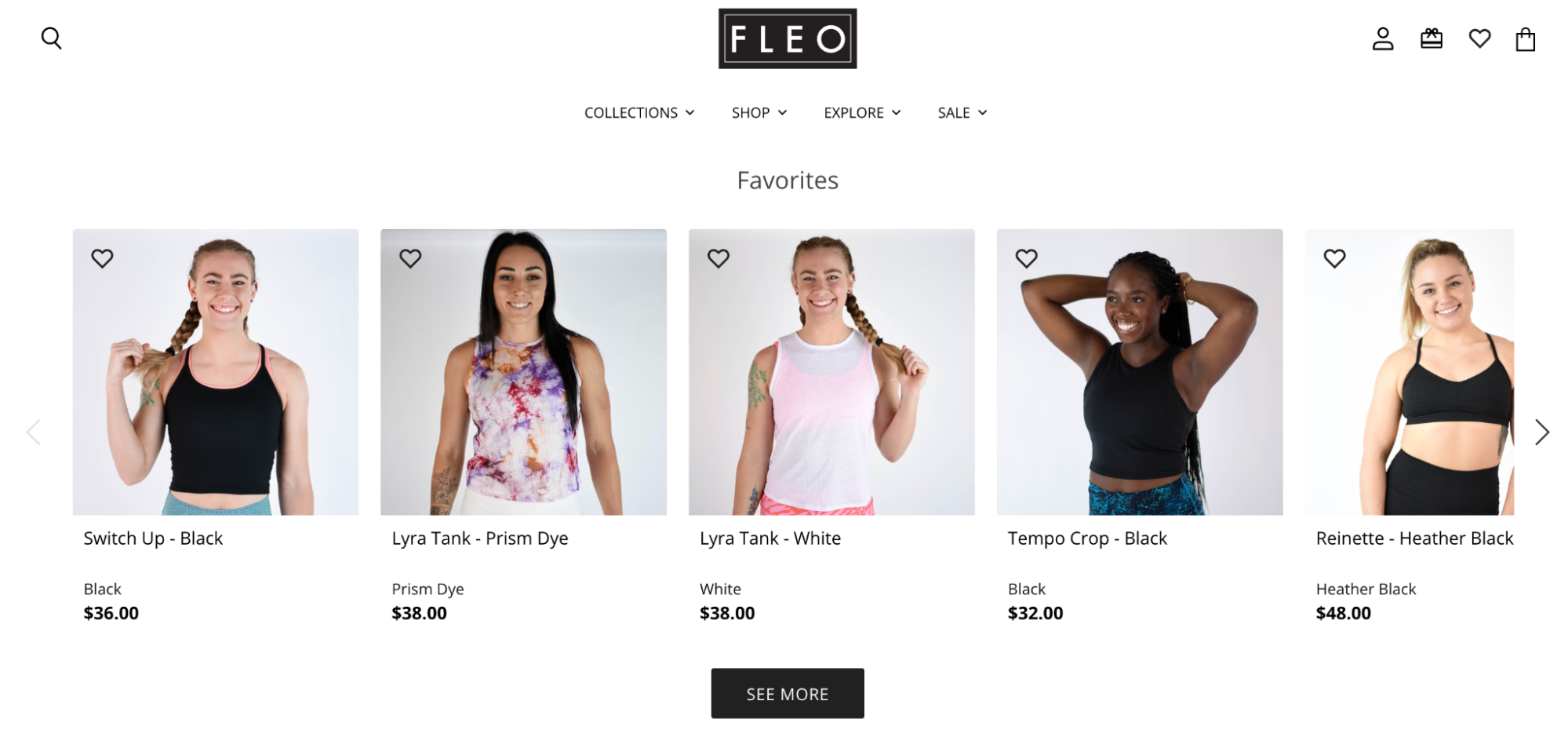
Or lifestyle imagery:
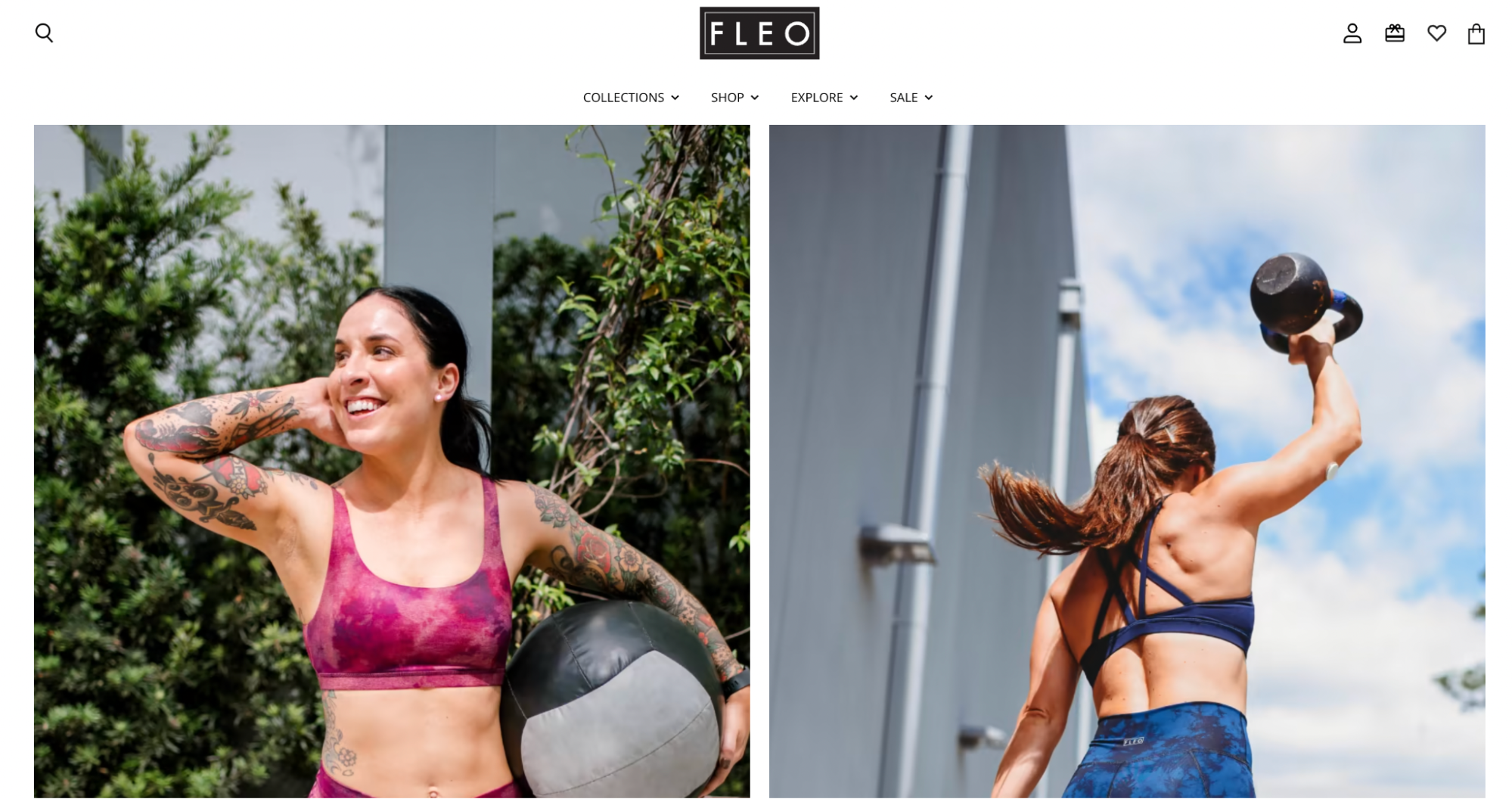
FLEO makes a point to use visuals of their core customer base. While this isn’t a new practice, FLEO has quite a few images throughout their site.
On a traditionally-built ecommerce site, this would likely cause issues with site performance.
But with FLEO’s headless site, they can add as many images as they’d like without causing performance issues. This is because PWAs load entirely only once, and then only fetch the needed sections as customers explore the site.
This eliminates the need to re-fetch data continuously with each page click, so the site remains blazing fast.
15. Bill Blass
Company size: 11 – 50
Founded: 1970
Headquarters: New York, NY
Bill Blass is an iconic “American style” brand that combines the practicality of sportswear with the sophistication of New York City fashion.
This DTC brand’s best CX move: The Bill Blass brand is known for blending practicality and chic styles. What better way to showcase this than by making their ecommerce site into a Bill Blass mood board?
Customers can shop the latest and greatest products, but they can also get a true feel for the brand and its own stylistic twist on everyday pieces like slip-on shoes and tote bags.
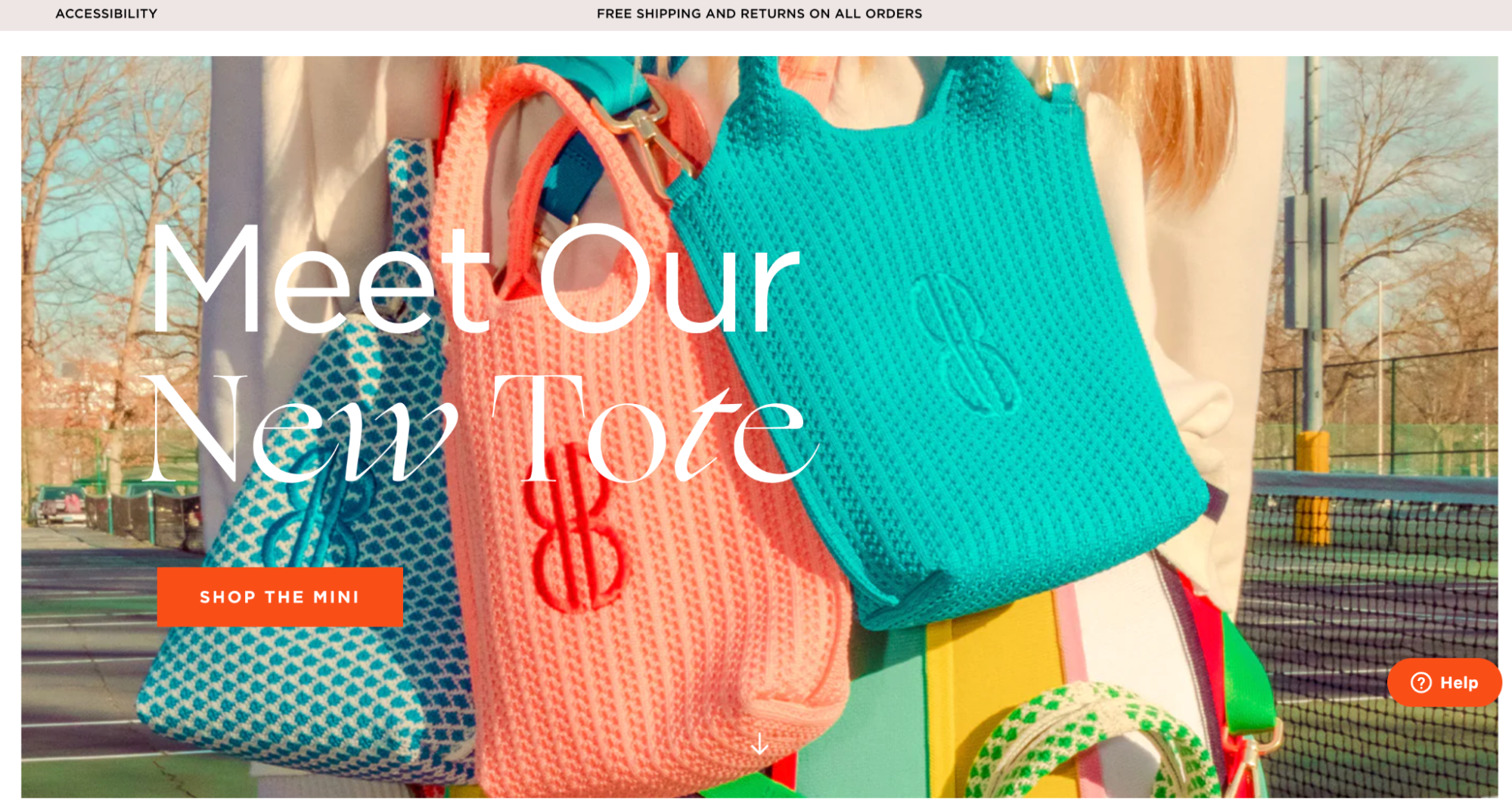

The fabric swatches, bold, magazine-esque fonts, and unique scroll CSS communicates the Bill Blass brand and pays homage to a classic.
Whether a customer has been a Bill Blass fan for decades or days, they’re sure to find style inspiration on this site.
16. Girlfriend Collective
Company size: 11 – 50
Founded: 2016
Headquarters: Seattle, WA
Girlfriend Collective is a sustainably-made activewear brand in sizes XXS – 6XL.
This DTC brand’s best CX move: Girlfriend Collective is a brand rooted in transparency—from how they source their products (like recycled water bottles, nylon, and other materials) to how they can encourage customers to take part in the sustainable fashion movement.
Girlfriend Collective offers a “ReGirlfriend” initiative where customers can purchase a return label, send back their loved items, and receive store credit.
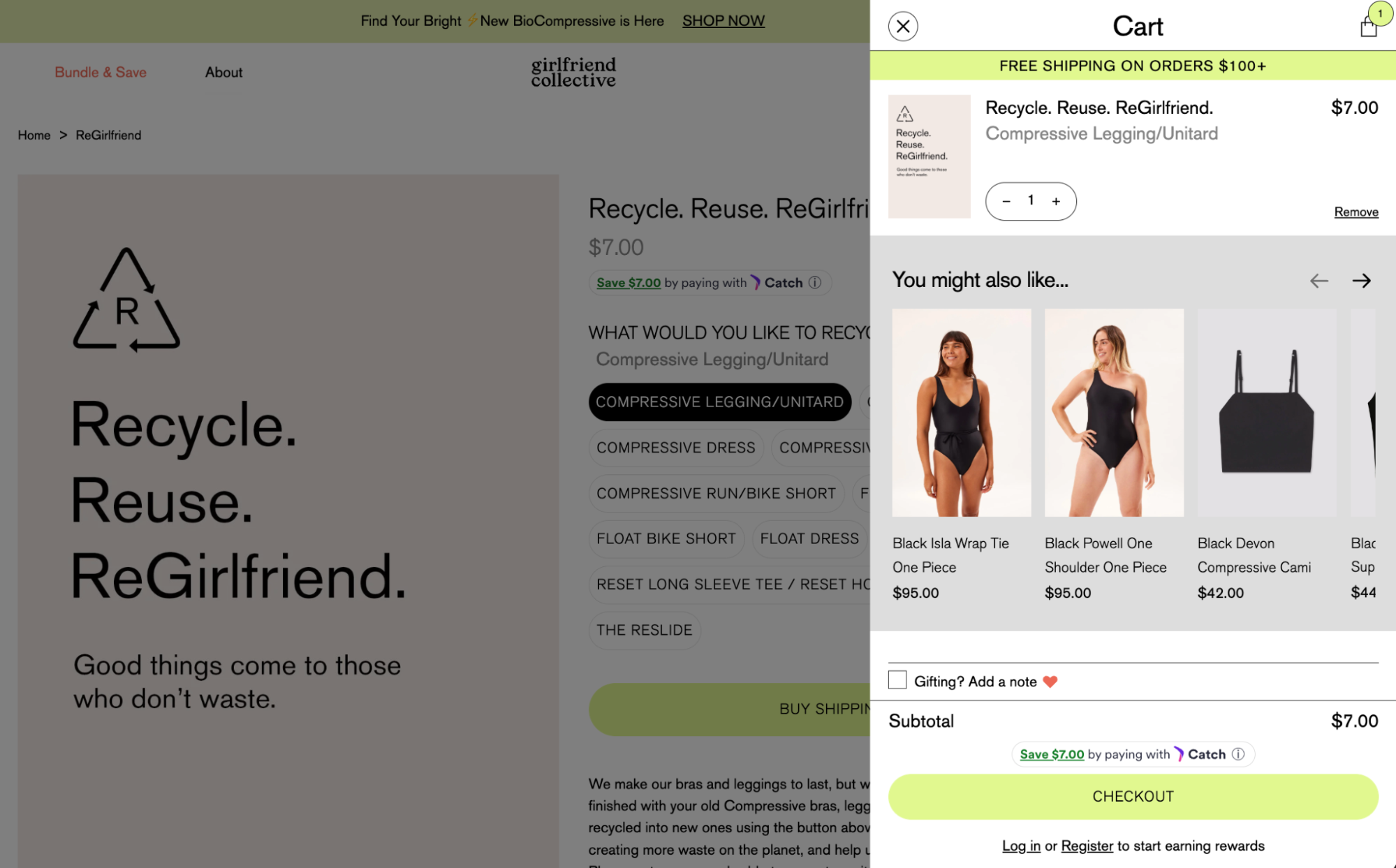
What better way to stick to and promote your values of sustainability and transparency than with an easy-to-participate program like this?
Plus, as more consumers continue to vote with their dollar when it comes to brands they buy from, this is a great way for Girlfriend Collective to practice what they preach.
17. Hockerty
Company size: 11 – 50
Founded: 2008
Headquarters: Zurich, Switzerland
Hockerty is a leading custom suit brand, offering a variety of fabrics, styles, and customization options for any occasion.
This DTC brand’s best CX move: If buying a suit online sounds risky, Hockerty is here to tell you that you’ve got nothing to worry about.
Aside from their intuitive suit customization experience:

Hockerty offers a “how to measure” video tutorial underneath where customers enter their measurements. This video walks customers through how to take their suit measurements at home.
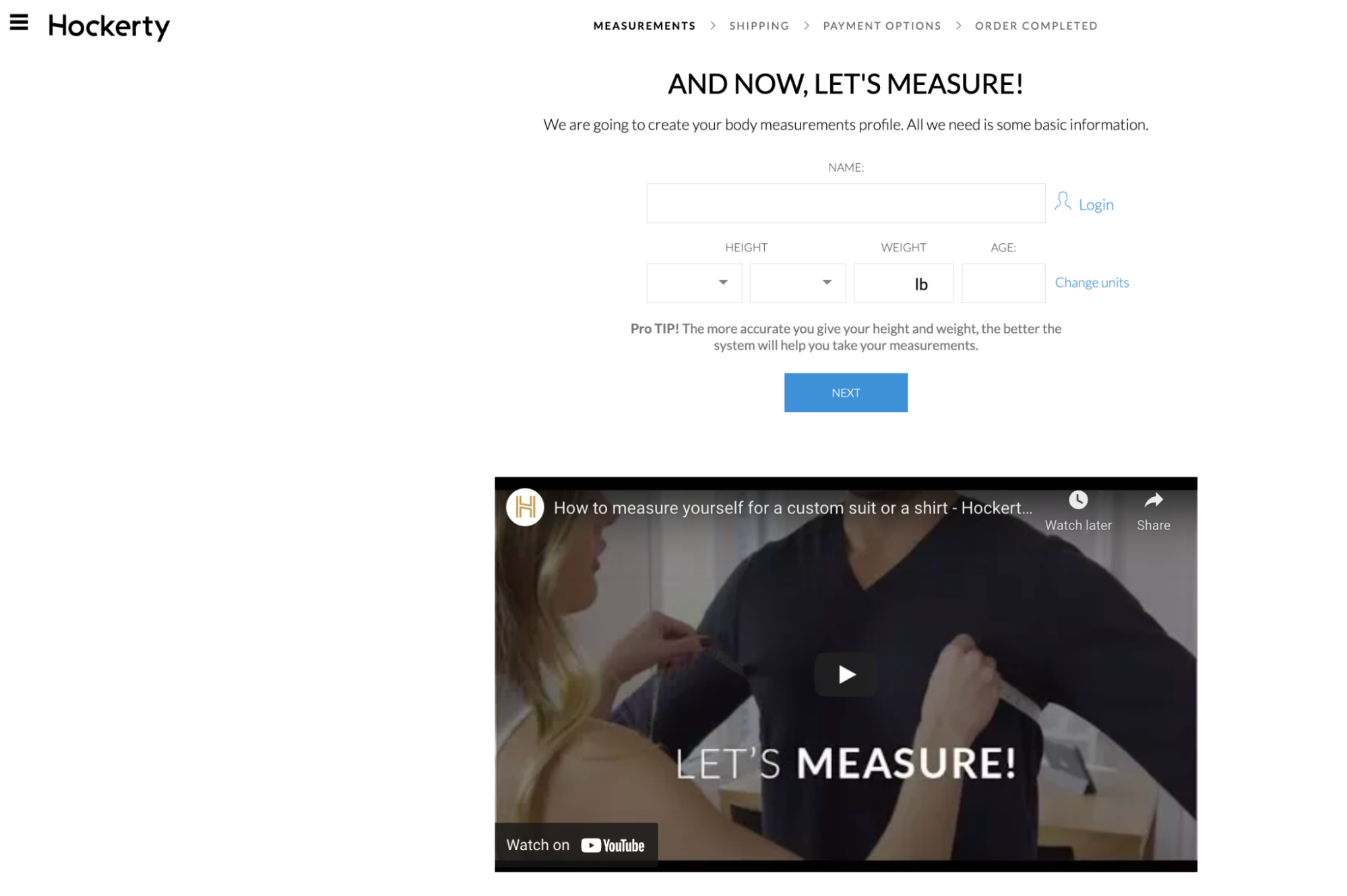
But if the suit arrives and it’s a little too big or small, Hockerty will cover alteration costs up to 25% of the garment’s value with their Perfect Fit Guarantee.
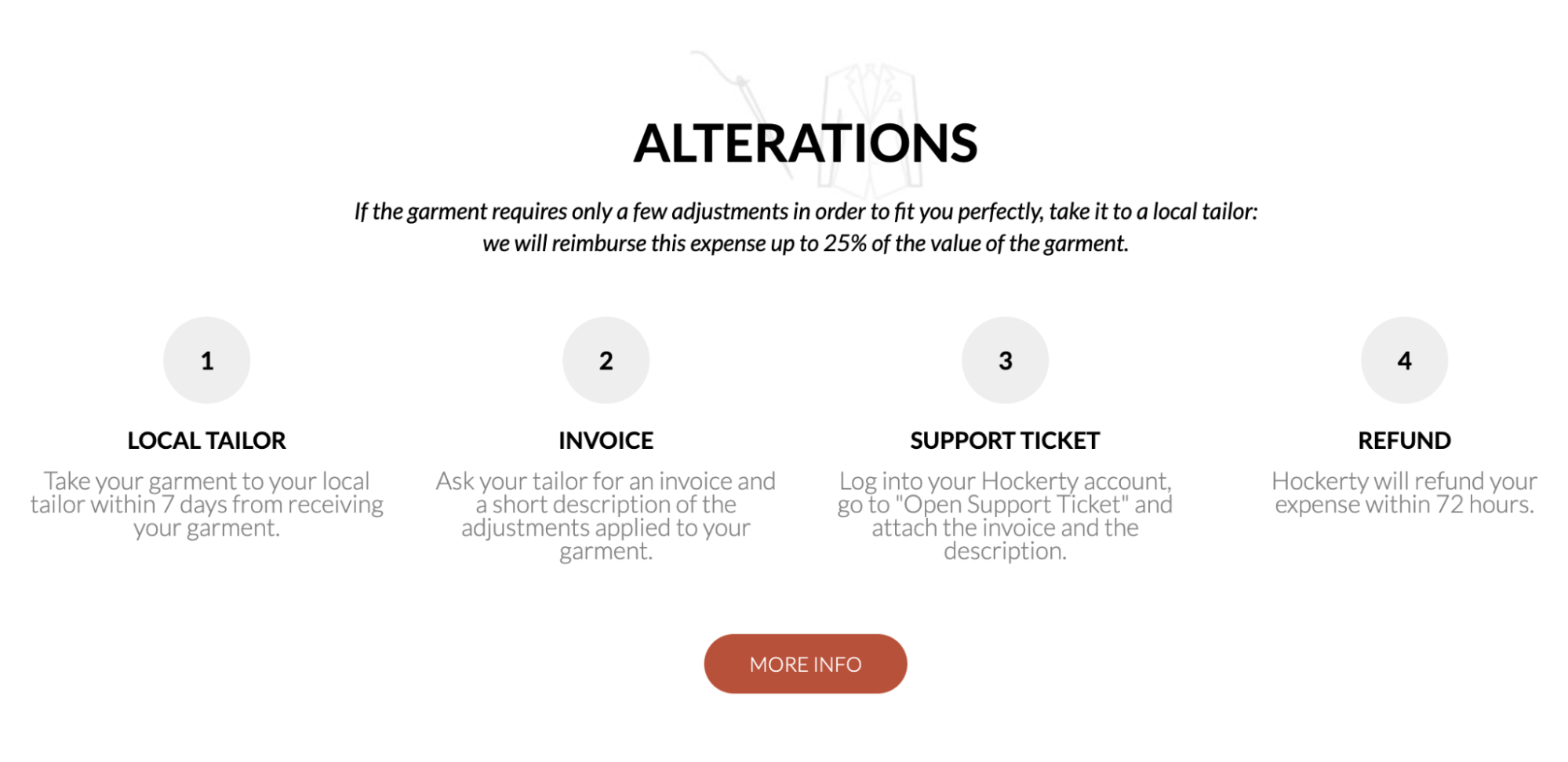
This is a great way to reduce friction for customers who may be skeptical about taking their own measurements or ordering a custom suit online.
Food and beverage DTC brands
The food and beverage industry is expected to reach roughly $857 billion by 2025. Consumers are still turning to ecommerce to shop for their favorites.
Let’s look at some of the rapidly-scaling brands in the space.
18. United Sodas of America
Company size: 2 – 10
Founded: United States
Headquarters: Brooklyn, New York, NY
United Sodas of America is a soda brand on a quest to craft the perfect, flavor-packed soda.
This DTC brand’s best CX move: United Sodas of America’s simple, bold branding certainly stands out. But as shoppers explore the site, they’re met with various unique scrolling effects:
As customers scroll through the home page, customers see a carousel-like effect:
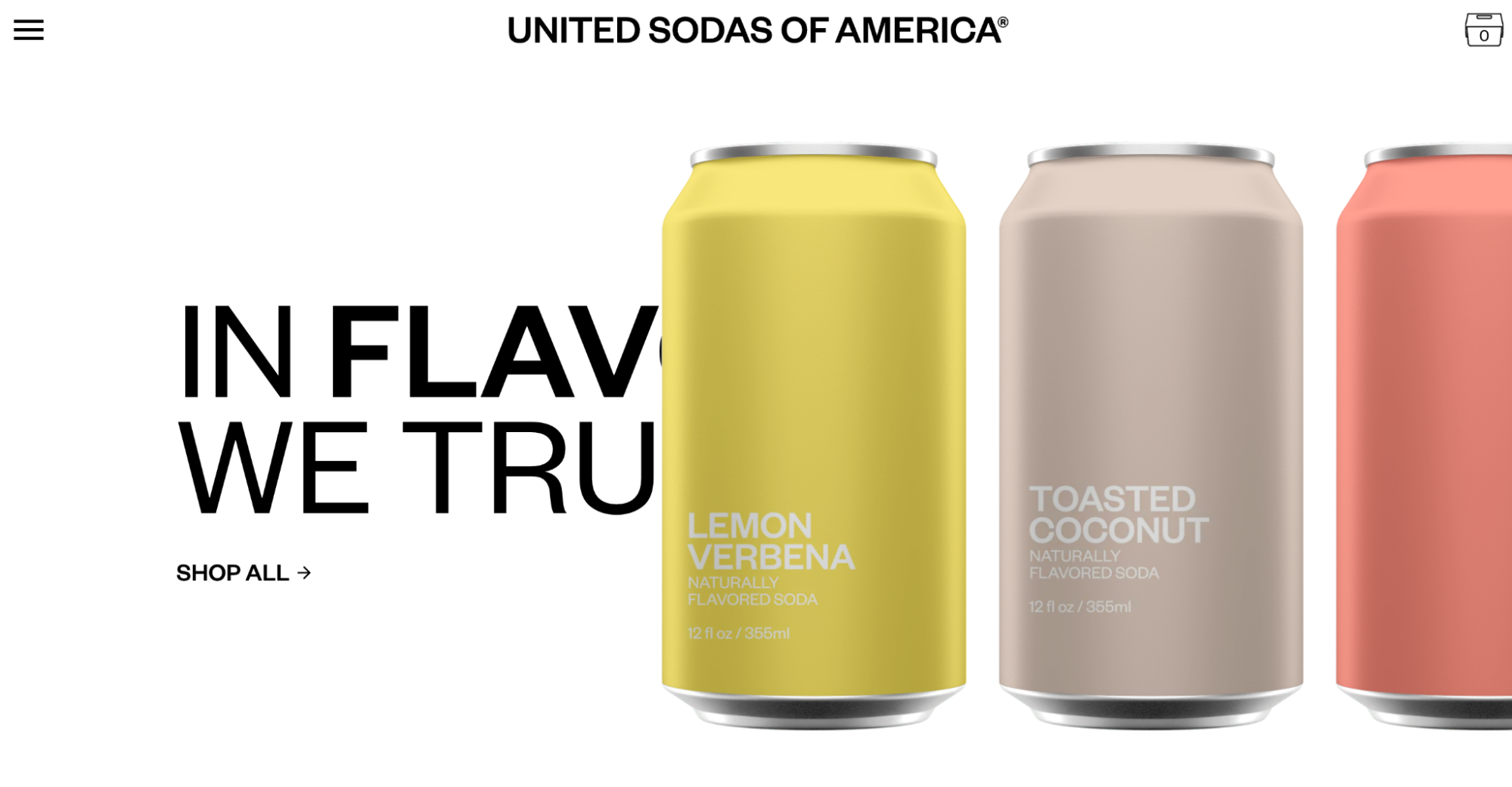
And on the product pages, customers can “grab” the can and spin it around:
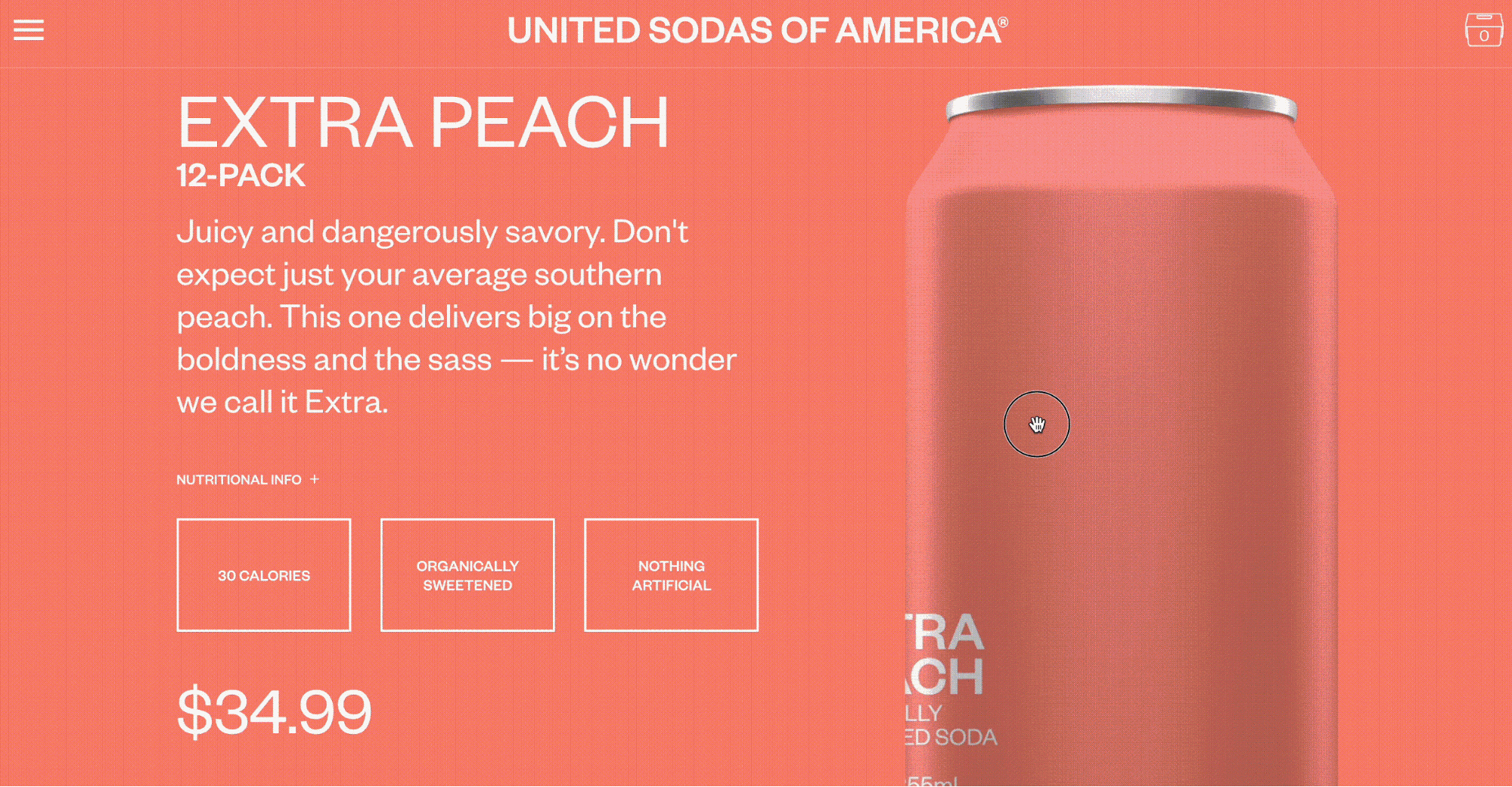
These design details make for a memorable shopping experience and speak to the playfulness of the brand, which helps establish a connection with shoppers.
19. Omsom
Company size: 2-10
Founded: 2018
Headquarters: New York, NY
Omsom is an Asian food brand offering “pantry shortcuts” via recipe starters to various Asian dishes.
This DTC brand’s best CX move: Aside from Omsom’s incredibly vibrant branding and site design, their personalization efforts are top-notch, too.
Omsom’s mission is to bring traditional Asian dishes into American homes, and that mission is threaded throughout their entire ecommerce experience. When shoppers land on the site, they’re greeted with an interactive video message from one of the founders of Omsom.
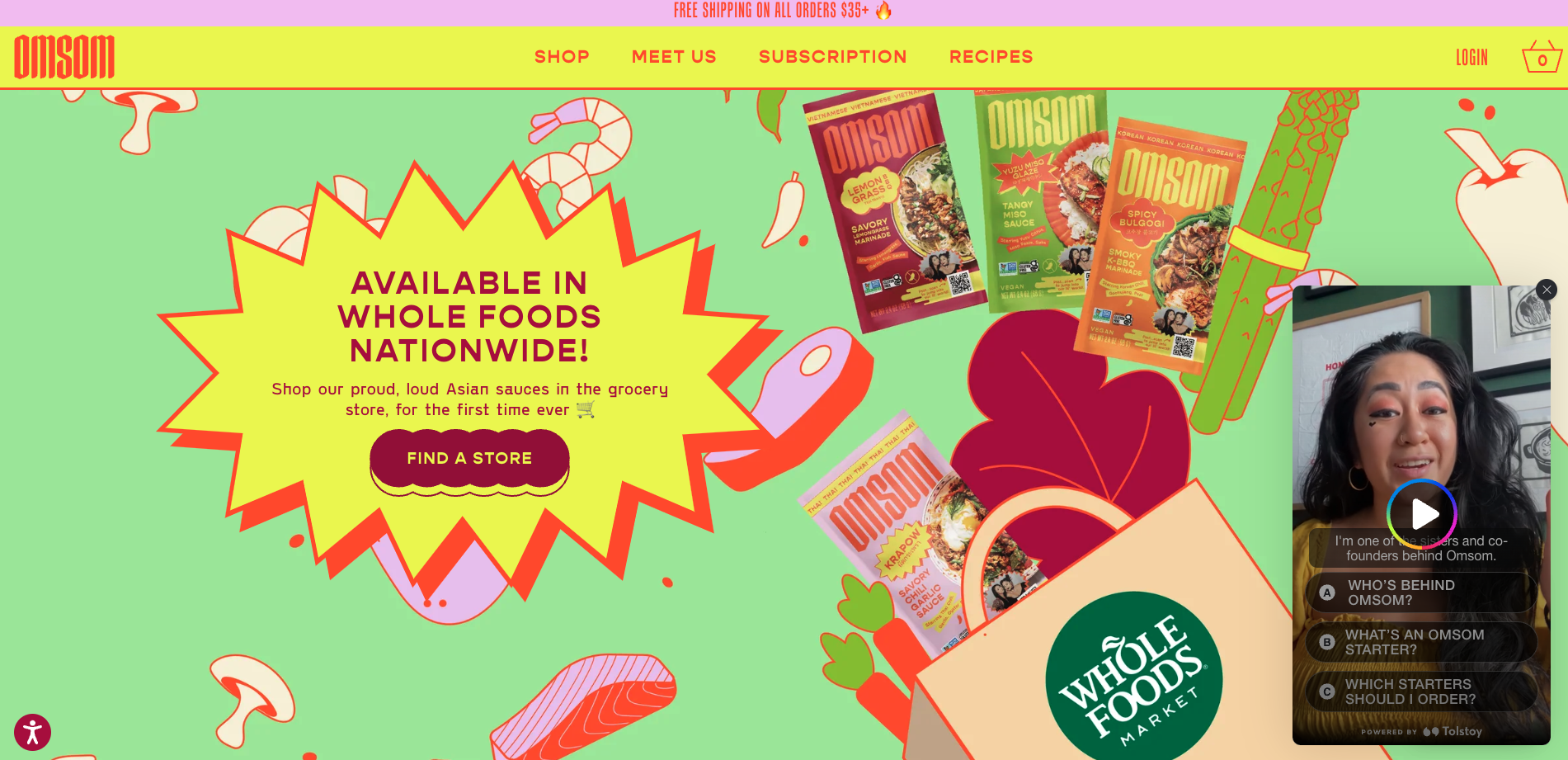
From there, customers can learn more about Omsom and their products in a choose-you-own-adventure way.

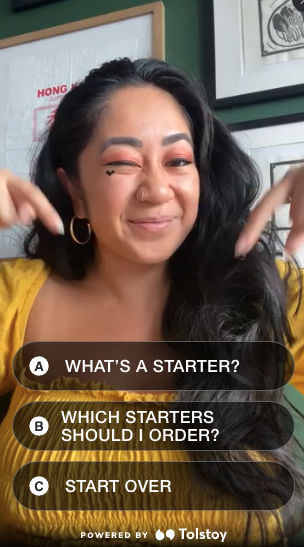
This feature helps with product discovery and education, and it’s a great way to introduce one of the real humans behind the brand as customers explore.
20. Daring
Company size: 51 – 200
Founded: 2018
Headquarters: Los Angeles, CA
Daring is a plant-based protein brand offering a healthier, more sustainable alternative to animal chicken.
This DTC brand’s best CX move: Daring understands that any interruption to the shopping experience could risk a sale. So, to mitigate this, they’ve added “Quick Add” buttons throughout the site and a pop-out cart window.

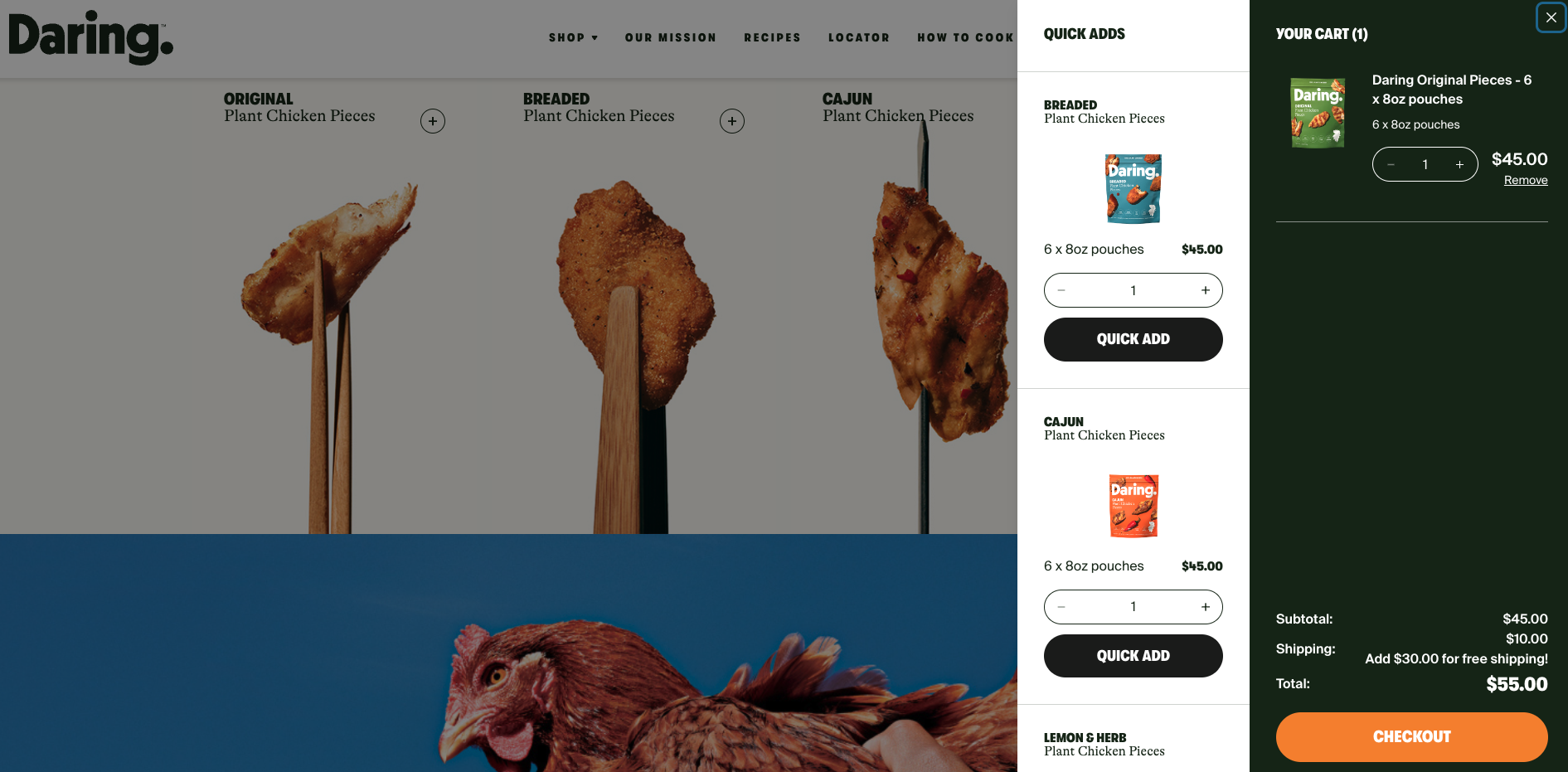
While this isn’t necessarily a new tactic for brands, it’s a great demonstration of eliminating friction in the shopping experience.
21. Notorious Nooch
Company size: 2 – 10
Founded: 2021
Headquarters: Marlborough, England
Notorious Nooch is a CPG offering naturally-flavored yeast flakes—or “nooch,” which tastes similar to cheese and is often a vegan alternative.
This DTC brand’s best CX move: If there was ever an award for the brand that makes shopping for nutritional yeast flakes engaging and fun, Notorious Nooch takes the gold.
This ecommerce site is packed with animations, stop-motion videos, and special scroll effects that make exploring this brand as entertaining as it is helpful.
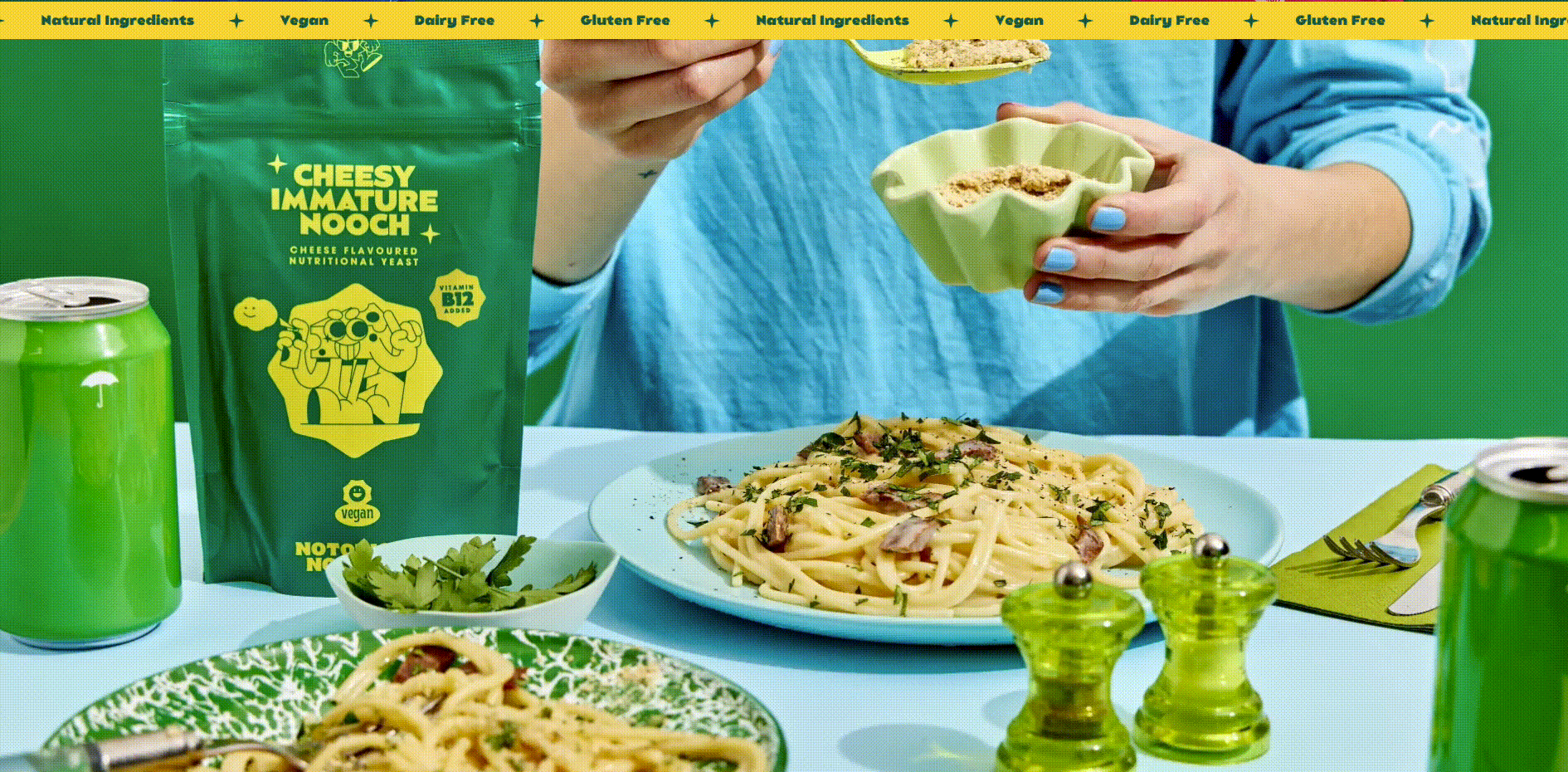
Plus, other fun animations speak to the true colors of the brand, which is key in building relationships with customers.

How Shogun can help your DTC brand succeed in a crowded market
Direct-to-consumer brands can control how their customers directly interact with their brand, which is quite an advantage in the ecommerce world.
With a powerful no-code page builder tool like Page Builder Advanced, you can create dynamic site pages in seconds with drag-and-drop functionality, pre-made templates, content syncing, and more.
#cta-visual-pb#<cta-title>Build a killer DTC storefront<cta-title>Build and customize your DTC store with an intuitive and code-free page builder app.Start designing for free

Kaitlyn Ambrose
Kaitlyn works on all things content at Shogun. ⚡



